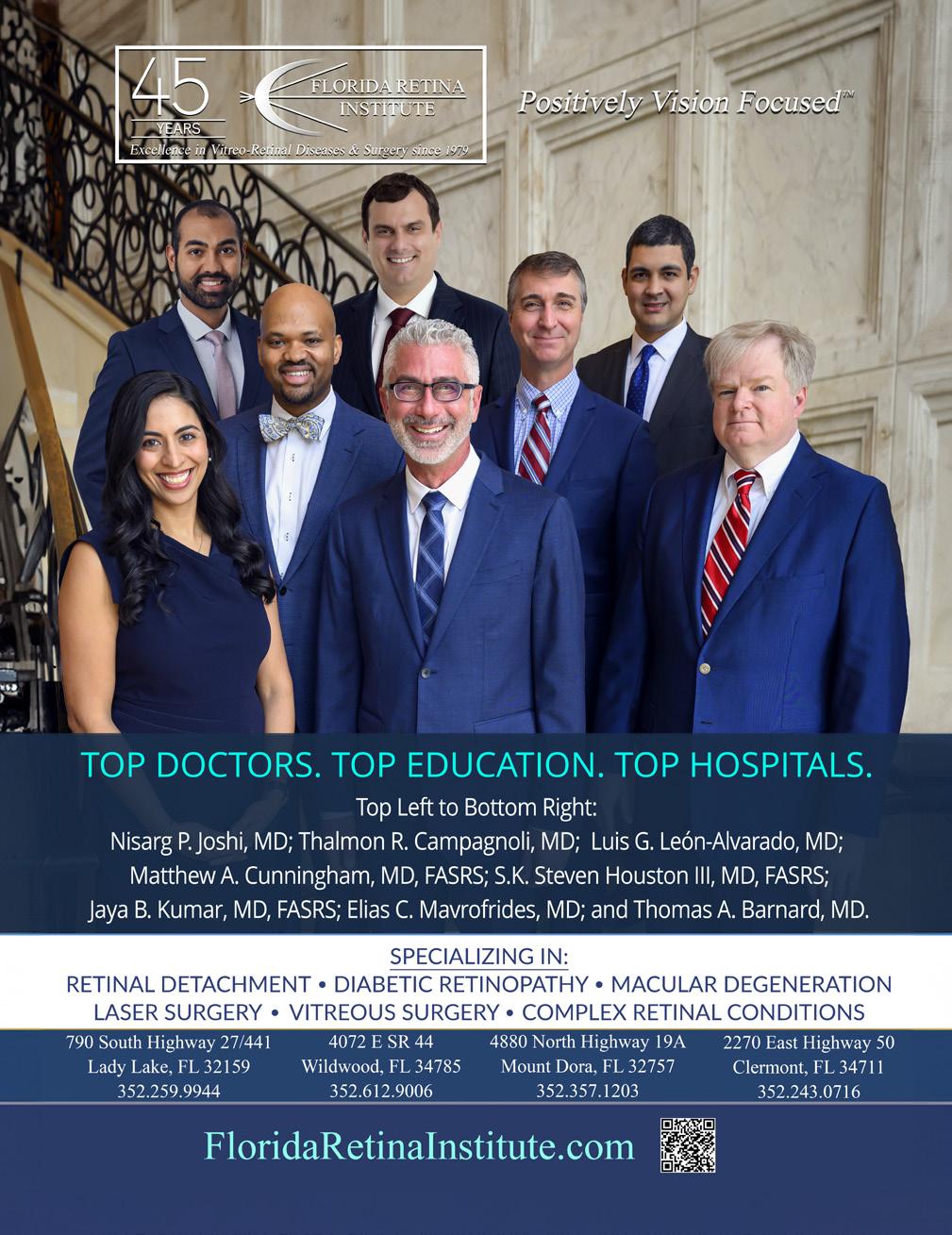

DIGITAL JUNGLE STAYING CONNECTED WITH YOUR KIDS BEYOND TECH DISTRACTIONS.
HEALTHCARE, SIMPLIFIED DISCOVER THE BENEFITS OF DIRECT-PAY MEDICAL CARE.
TOGETHER FOR BETTER HOW A HAPPY MARRIAGE BOOSTS YOUR HEALTH.















DIGITAL JUNGLE STAYING CONNECTED WITH YOUR KIDS BEYOND TECH DISTRACTIONS.
HEALTHCARE, SIMPLIFIED DISCOVER THE BENEFITS OF DIRECT-PAY MEDICAL CARE.
TOGETHER FOR BETTER HOW A HAPPY MARRIAGE BOOSTS YOUR HEALTH.












Your heart works hard for you every day. But is it as healthy as it could be? For men and women aged 55 and over, regular heart health check-ups are crucial. Prioritize preventative care to catch potential issues before they become serious. Our comprehensive cardiology services include state-of-the-art diagnostics, personalized care plans, and expert advice to help you maintain a healthy heart.
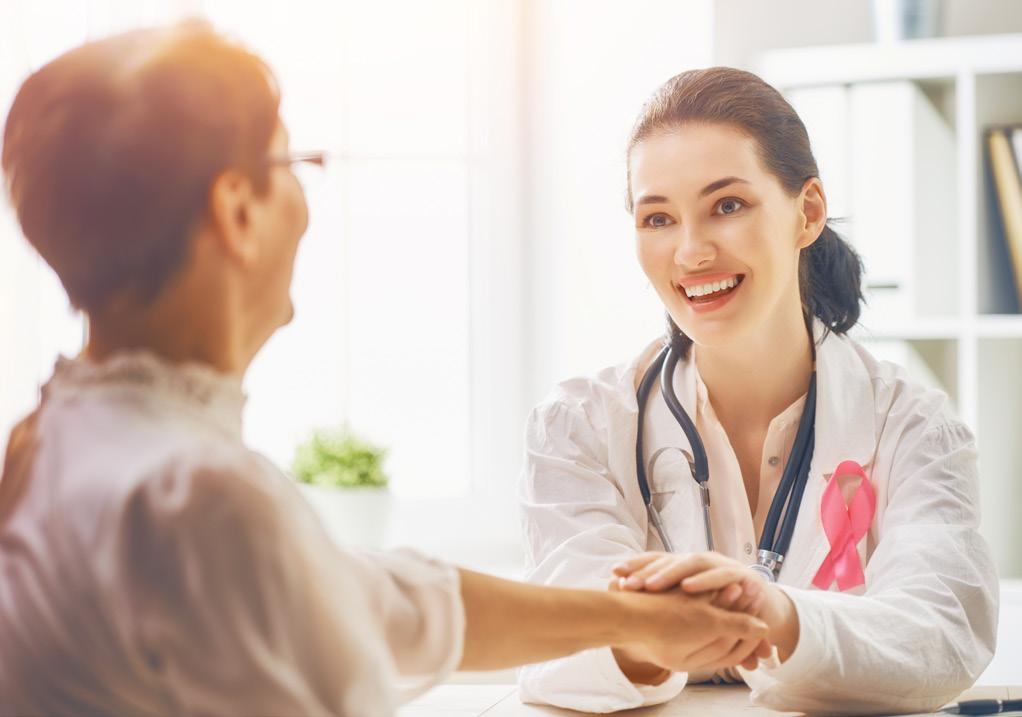
found a lump in my breast.” We hear this line most often concerning breast cancer detection, but breast cancer can exhibit other signs, too. Some may be due to benign causes, but see your doctor if these signs persist or worsen:
1 . A thickening inside your breast or in your breast skin.
2. A dimple or indentation in your breast.
3. A crust on your nipple.
4. Redness, swelling, or heat in your breast that doesn’t go away with antibiotics.
5. Nipple discharge not associated with developing breasts, infection, cysts, pregnancy, or breastfeeding.
6. Skin sores developing on your breast, usually associated with a hard lump.
7. A bump on the breast. (These can also be benign lumps or cysts.)
8. A nipple that fl attens or turns inward.
9. Newly appearing blood vessels or veins on the breast or near the collarbone (if not connected to weight gain, breastfeeding, or Mondor’s disease).
10. Changes in breast size, fl attening, swelling, or drooping, not due to breastfeeding or menstruation.
11. Your breast looks like the dimpled skin of an orange and might change color. This is a sign of infl ammatory breast cancer.
12. A hard, immovable lump deep in your breast is the most common breast cancer symptom, though it may also be a cyst.
Dense breasts can spell the difference between fi nding a tumor and missing one. Dense breasts and tumors look similar on a mammogram, so further screening like ultrasound or a breast MRI may be needed. Talk to your doctor.


RBOI radiation oncologist Dr. C. Joseph Bennett recommends the following to lower your breast cancer risk:
1. Avoid being overweight. Try to maintain a body-mass index under 25.
2. Eat a healthy diet, including vegetables, fruit, lean protein, whole grains, and vegetable oils. Try to avoid sugared drinks, refi ned carbohydrates, fatty foods (including animal fats), and red meat.
3. Keep physically active. A 30-minute walk, fi ve days a week, can reduce your risk.
4. Avoid alcohol: no more than one drink per day.
5. Don’t smoke. RBOI tobacco cessation specialist Wendy Hall, LCSW, can help you quit. Call her at 352-527-0106.
6. Avoid hormone replacement therapy if possible.
7. If you give birth, breastfeed your babies for as long as possible.
8. If you are at high breast cancer risk, consider taking an estrogenblocking drug. Talk to your doctor if you have a family history of breast cancer or are over age 60. BPH and prostatitis are not risk factors for prostate cancer.
310,720
Estimated new cases of U.S. women’s breast cancer in 2024
RBOI’s support groups are available at no charge during and after treatment. Our Breast Cancer Educational Groupmeets in Lecanto. Our Women’s Cancer Support Group meets online via Zoom.
13.1%
Women expected to be diagnosed with breast cancer at some point during their lifetime, based on 2018–2021 data, excluding 2020 due to COVID
RBOI’s resource rooms in Lecanto and Ocala offer wigs, hats, and blankets free to any Citrus County resident undergoing cancer treatment, regardless of where they receive care. Residents can also obtain fi nancial assistance from the Citrus Aid Cancer Foundation. Marion County residents can use RBOI’s resource room in Ocala and receive fi nancial assistance from the RBOI-sponsored H.U.G.S. charities. Call us for more information about these and other resources helping our community.
1 in 100
Breast cancers diagnosed in the U.S. in men
1.2%
Annual drop in the death rate for women with breast cancer, from 2013 to 2022
Patient-centered radiation oncology close to home
The Villages 352.259.2200
Ocala 352.732.0277
Timber Ridge 352.861.2400
Inverness 352.726.3400
Lecanto 352.527.0106
RBOI.com

Like us on Facebook





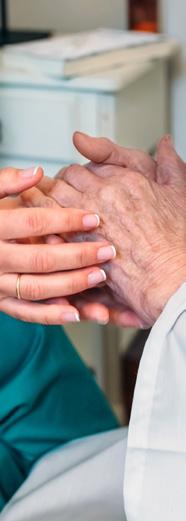
Autumn recipes sure to bring cozy and comforting vibes to your table, complete with a zero-alcohol drink pairing to spice things up.
Recipes: Louis Santiago and Taylor Boyd
Story: Gina Horan
Story: Sabrina Ciceri
Story: Christine Andola

Story: Roxanne Brown
Story: Roxanne Brown

Story: Gina Horan


Welcome to another exciting issue of Healthy Living Magazine! This month, we are thrilled to bring you an array of inspiring and informative articles that cover the latest in health, wellness, and lifestyle. Our team has been hard at work curating content that not only enlightens but also empowers you to lead a healthier and happier life.
First, we explore some groundbreaking medical advancements that are set to revolutionize healthcare. From cutting-edge treatments to innovative technologies, these breakthroughs promise to enhance our understanding and management of various health conditions.
Next, we take a deep dive into the world of infrared saunas. Known for their numerous health benefits, including detoxification, improved circulation, muscle relaxation, improved vision and overall optical health, infrared saunas are quickly gaining popularity. Learn how incorporating this modern wellness trend can enhance your well-being.
Maintaining a happy and healthy marriage is essential for emotional and mental well-
being. In this issue, we share expert advice and practical tips on how to nurture your relationship, communicate e ectively, and grow together as a couple.
Lastly, with the presidential election approaching, it’s easy to feel overwhelmed by the negative political ads and rhetoric. Now more than ever, we emphasize the power of maintaining a positive attitude. A positive mindset can significantly improve your health, relationships, and overall quality of life. Discover strategies to cultivate positivity, overcome challenges, and lead a more fulfilling life.
We hope you enjoy this issue as much as we enjoyed putting it together. Your feedback is invaluable to us, so please share your thoughts by visiting our website at healthylivingcf.com. For additional content and exclusive updates, don’t forget to check out our digital issues and podcasts.
Here’s to living your healthiest and happiest life!
Kendra Akers
OWNER/PUBLISHER kendra@akersmediagroup.com
Doug Akers PRESIDENT doug@akersmediagroup.com
DESIGN | PHOTOGRAPHY | EDITORIAL
Michael Gaulin CREATIVE DIRECTOR michael@akersmediagroup.com
Shawnee Coppola ART DIRECTOR shawnee@akersmediagroup.com
Travis Hajenga DESIGNER travis@akersmediagroup.com
Roxanne Brown MANAGING EDITOR roxanne@akersmediagroup.com
Gina Horan STAFF WRITER gina@akersmediagroup.com
Nicole Hamel CHIEF PHOTOGRAPHER nicole@akersmediagroup.com
Cindy Peterson DIGITAL MEDIA EDITOR & PHOTOGRAPHER cindy@akersmediagroup.com
Kyle Coppola DIGITAL MEDIA SPECIALIST & SPORTS WRITER kyle@akersmediagroup.com
Cynthia McFarland Sabrina Ciceri Christine Andola
Marc Robertz-Schwartz Cadi Schwartz Chef Louis Santiago
Gary Corsair Katie Sartoris
Tim McRae VICE PRESIDENT, SALES tim@akersmediagroup.com
Melanie Melvin ADVERTISING REPRESENTATIVE melanie@akersmediagroup.com
Shaena Long ADVERTISING COORDINATOR shaena@akersmediagroup.com
ADMINISTRATION
Emily Gaulin OFFICE MANAGER emily@akersmediagroup.com
Aubrey Akers Simmons ACCOUNT & CLIENT SERVICES aubrey@akersmediagroup.com
DISTRIBUTION
Frank Suarez DISTRIBUTION MANAGER







Until next time, Kendra
Akers







days, this type of therapy has caught up with modern science. Now called “cryotherapy,” this type of stimulation uses modern technology.**
Local cryotherapy is a cryostimulation treatment that increases blood flow to injured or sore muscles and joints. Extreme cold applied to the injured area stimulates oxygenated blood flow, reducing tension and inflammation. If you are interested in this type of therapy or pain management nearby, try:
Working on Wellness
9738 US Hwy 441, Ste. #106, Leesburg | 352.235.8139
WorkingOnWellness.net
Impact Bodyworx
2575 Kurt St., Ste. 103, Eustis | 352.801.1523
ImpactBodyWorx.com
Elite Recovery and Cryo (Cryo chamber only)
2410 E. SR 50, Clermont | 352.459.8148
EliteRecoveryCryo.com
**For extreme injuries or pain, see a specialist or a primary care physician.


The UF Health Spanish Plaines Hospital Auxiliary Foundation’s ninth annual Hearts for our Hospital Bicycle Challenge will take place on November 9 at La Hacienda Regional Recreation Center in Lady Lake. The challenge features five route options for cyclists of all levels, fully stocked rest stops and a post-event lunch. For more information or to register for the event, visit this website: https://heartsforourhospital.raceroster.com/
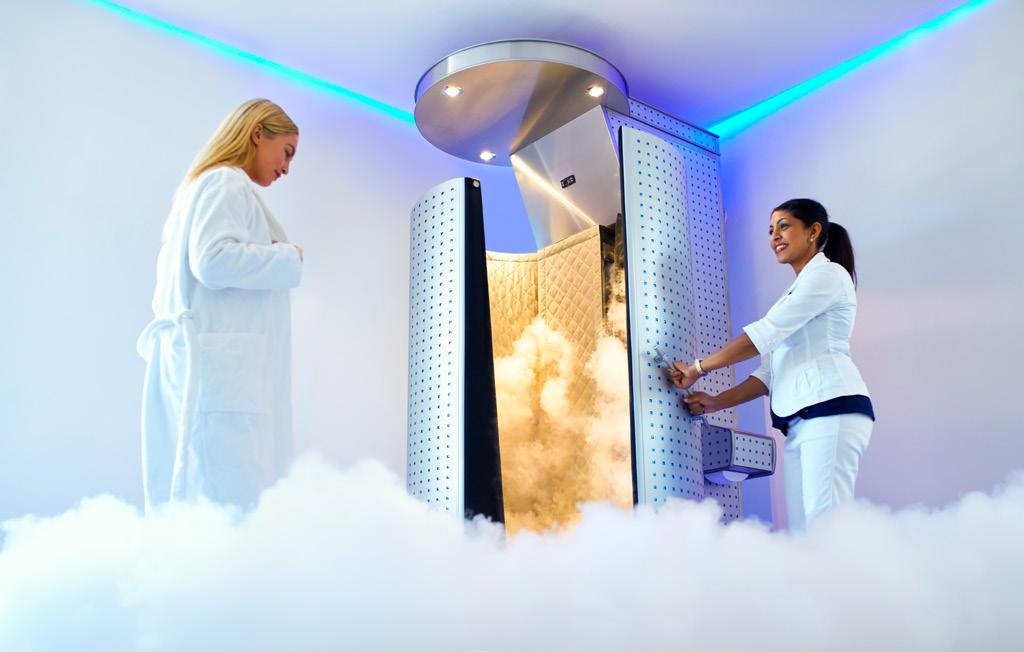

Citizens First Bank has stepped up to teach kids how to save and spend wisely through special programs tailored for our youths.
“We believe that you’re never too young to start learning fiscal responsibility,” says Josh Gonzales, first vice president and senior commercial banker. “Our goal is to impact students in all grades in the communities we serve as we teach them about the importance of financial education.”

SOME OF THE PROGRAMS THEY OFFER ARE:
• Reading financial literacy-themed books to kindergarten-2nd grade elementary school students, then donating the books to the classrooms for continued use.
• Educating middle and high school students on financial literacy of managing money, setting goals, budgeting and the importance of good credit.
• For parents ready for their child to take that next step in developing good financial habits, they o er youth savings and student checking products.
Cannabidiol (CBD) is a beneficial compound extracted from the cannabis plant, specifically from the hemp variety. Unlike tetrahydrocannabinol (THC), CBD is nonpsychoactive and is known to promote better sleep and relaxation and provide mild pain relief.
Consumable and topical CBD products that contain less than 0.3% THC can be purchased and used legally by anyone over age of 18 in Florida. You must be at least 21 to purchase inhalants.
Medical marijuana is legal in Florida with a prescription from a licensed physician if the patient meets certain medical diagnoses such as cancer, epilepsy, ALS and PTSD. For more information, consult the o ce of medical marijuana use at: www.mmuregistry.flhealth.gov
United Way of Lake and Sumter Counties will host a 100bird fundraiser tournament on October 18 at Blackjack Sporting Clays in Sumterville. There will be a safety
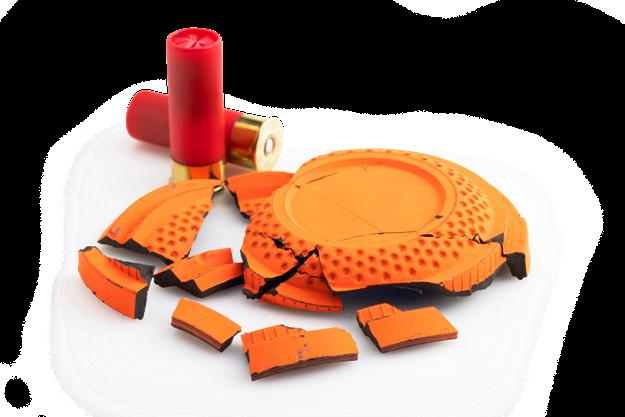
Breast cancer is the most common cancer among women in Florida, and regular mammograms help doctors detect breast cancer early. A guide to help low-income women who need this valuable tool is offered at www.freemammograms.org.

Enjoy a day of health and wellness for the whole family on October 26 at the World Equestrian Center. Engage in interactive and educational exhibits, participate in free health screenings, learn about wellness trends and qualify for free gifts and giveaways throughout the day. Celebrate health, wellness and community at this exciting indoor event.
RESERVE YOUR FREE TICKETS HERE: https://www.bmgevents.com/health.html

Financial crimes against seniors are on the rise. According to the National Council on Aging, in 2022 there were almost 90,000 complaints of fraud, resulting in over $3 billion in losses from people aged 60 and older.

1. 2 3 4 5
Government impersonation.
A caller falsely claiming to be with the IRS or Medicare asks for a Social Security number.
Sweepstakes and lottery.
A caller says that you won a big prize. You just need to pay the “shipping costs,” and they ask for a credit card number.
The “can you hear me” scam.
A caller will ask a question and record your answer then use AI to pretend to be you.
The tech scam.
Online scammers will inject fake links and once you click, you go to a fake 800 number claiming to help if you give them a credit card number.
The grandparent scam.
The caller pretends to be your grandchild, says they are in trouble and then asks for a money transfer.
If you feel as though you’ve been ripped o by a shady scammer, call Elder A airs Florida at 800.963.5337, Marion Senior Services at 352.620.3501 or visit www.eldera airs.org.

Silver River Museum & Environmental Education Center will host a living history exhibit November 9 and 10 from 9am to 4pm. The weekend-long Ocali Country Days Festival will include food vendors, unique crafts for sale, demonstrations of life in the 1800s, tram rides through the state park and tours of the Silver River Museum. This annual festival is fun for the whole family. For more information or to buy advance tickets, visit their website: https://silverrivermuseum.com/ event/2024-ocali-country-days/
Locally grown food makes the healthiest meals, and the farmers market at The Market of Marion o ers a steady supply all year round. The farmers market at 12888 SE Hwy. 441 in Belleview features vegetables, eggs, honey, fish and much more. The market is open Friday from 8am to 3pm and Saturday and Sunday from 8am to 4pm. Talk to the farmers and learn about how your food is grown while selecting the freshest produce available.
STORY: CHRISTINE ANDOLA
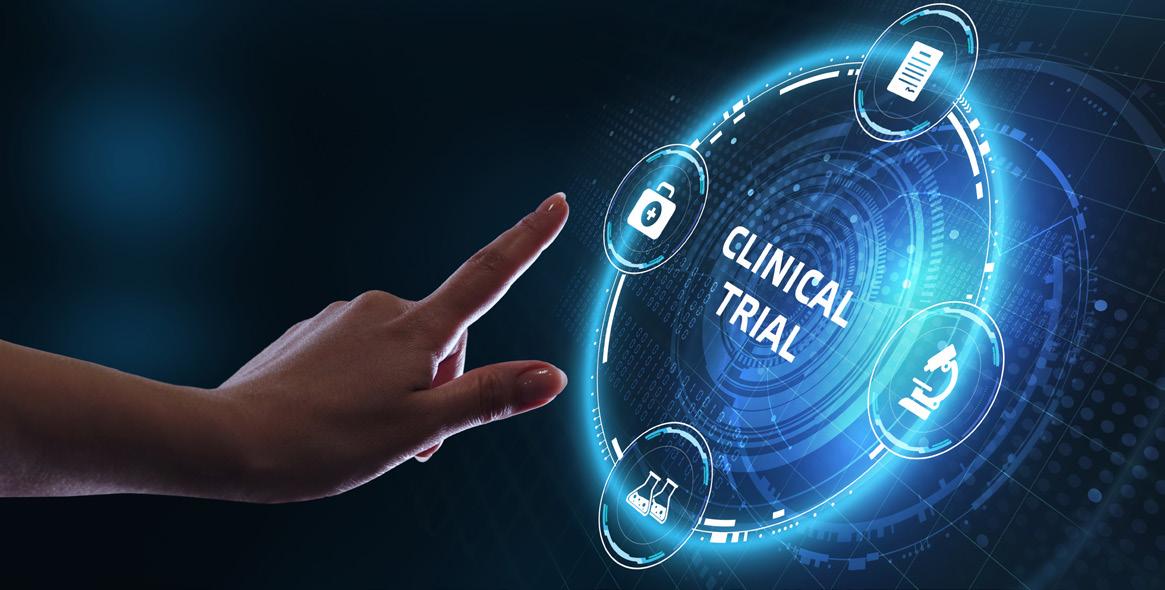
If you are battling a life-threatening disease and your doctor offers to get you into a clinical trial, that means there is nothing more the physician can do for you. You are looking for a miracle.
Fact:
Clinical trials o er new treatment options, if you are fortunate enough to live near a research hospital. A trial is not necessarily your last resort, but it could be a better way to treat your disease.
Standard treatments are always available, but there are limited spots in a clinical trial.
“I always recommend patients go with the trial fi rst, if they can get in. The other treatment will always be there if the trial doesn’t work for them,” says Dr. Maen Hussein, oncologist at Florida Cancer Specialists.
A clinical trial means the treatment protocol has already
been studied extensively. Trials are divided into three phases. In phase 1 trials, the drugs are not yet proven outside of the lab. Few patients are accepted into phase 1 trials; those are for patients who have tried everything else and may be looking for a miracle.
Phase 2 trials confi rm that the treatment works and establishes its safety.
“In phase 3 clinical trials, we know the drug works. We just don’t know yet if this treatment is better than the one we already have,” Dr. Hussein explains. He also points out that patients in a clinical trial are followed very closely and may actually get better care than
if they went through a standard treatment protocol.
The Federal Drug Administration (FDA) oversees medical research to protect patient rights and verify the quality and integrity of the data used in the approval process. According to the FDA website, there are currently almost 3,000 clinical trials taking place in the Central Florida region.
The best way to fi nd a clinical trial that might be appropriate for you is to ask your doctor, but the FDA website has a search feature and other resources to help you learn about clinical trials in your area.

TO READ MORE INFORMATION FROM THE FDA.



In a younger face, we typically see the heart-shape or V-shape look of youth. With age, gravity, and loss of skin elasticity, we can observe the stigmata of old age: nasolabial and marionette lines, jowl formation, and a turkey gobbler neck.
We can reestablish that heart-shaped look of youth with Face and Neck Lift with Smartlipo. This procedure combines a face and neck lift with laser liposuction along the jawline and neck using Smartlipo technology.
With today’s modern technology, you can truly look on the outside the way you feel on the inside. Call for your free consultation with Dr. Serra to find out if Face and Neck Lift with Smartlipo right for A New You!












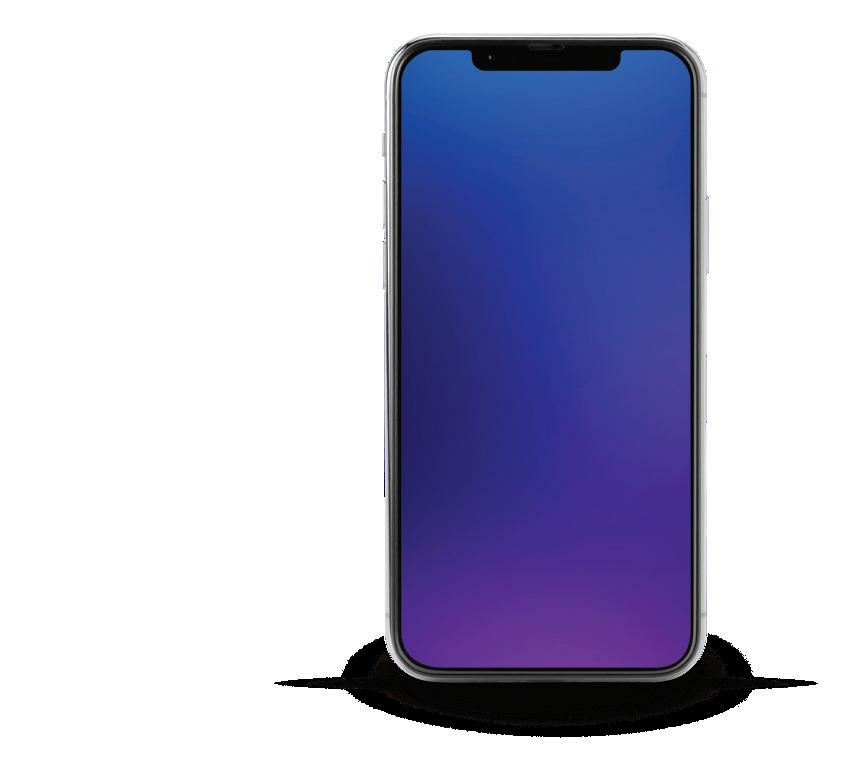



Let’s be honest, our phones have become an extension of our lives, bodies, days (and nights) and our society. But as long as we’re being honest, we have no
Villages Media Group circa 2003, I was given a Nextel phone to carry at all times. I hated it. I hated the ‘beep-beep’ and even more, hated hearing the sound in places like restaurants, movie theaters and even around the o ce. Sure, we’ve come a long way with today’s smart phones. Or have we? Do we really need to hear your
conversation about your polyps on speaker phone while blocking me in the cereal aisle? No. We most certainly do not.
Having said that, I, along with my wife, who worked in the cell phone industry for years, decided early on to set rules and boundaries in our home; particularly with ‘the kid’ on the adjoining page. The rules were pretty straightforward; no phone until she was 13 years old, and we were all prohibited from bringing


While I know that my dependency on devices won’t go away anytime soon, I am trying to do less mindless scrolling and instead use them for more intentional purposes.
our phones to the dinner table, into the bathroom or into the bedroom at night. That changed very recently when we “cut the cord,” no longer having a landline, allowing our phones on the night table in do-notdisturb mode in case of emergency. What I quickly learned, particularly if our daughter was having a friend sleep over, was other parents did not share our boundaries, making it di cult, if not confrontational at times, when we told our overnight tween guest what the house rules were. In fairness, we’ve had adult guests who we’ve tactfully asked not to bring their phones to the table during meals.
As a business owner, I made a conscious decision to not send o ce emails to my phone. It is my last bastion of privacy and sanity. For the most part, my clients are good with it, if not envious. But newer ones, who are not aware of my preference, have questioned why I didn’t respond to their email at 8:32pm on a Sunday, let alone how I can run a business these days without immediate access to email. And that’s the point; I am running my business, not allowing my business emails to run me!
That said, I’m not perfect. Sometimes, I’m hypocritical. But it’s an addiction for us to each manage individually. And if you disagree, send me an email. Just don’t expect a reply outside of o ce hours.


Ok, I’ll admit it… I take my phone almost everywhere. If it’s not in my pocket or my hand, it’s close enough to stay connected to my Apple Watch. I wasn’t always like this though.
I got my fi rst phone when I was 7. It was a TracFone with a keypad and you had to push the number 2 three times to text the letter “C.” It wasn’t until middle school that I was allowed to purchase my fi rst smartphone. That purchase came with rules. No phone in my room at night and no phone at the dinner table. I grew to respect that; I knew my parents just wanted to maintain a phone/life balance.
When I lived in a dorm in college and there was no way to put my phone in another room, I started bringing my phone to bed with me. That habit stuck, as I still bring my phone to bed and use it as my alarm. I won’t deny that most nights, I find myself scrolling before falling asleep.
One rule that I have continued to follow is no phones at the dinner
table. It doesn’t matter if I am with family or friends, at home or in a restaurant, I believe in being present and putting my phone down. I approach it as “out of sight, out of mind,” and keep it o the table. I also think there are other times and places where phones are inappropriate. These situations are up to your discretion, but you won’t catch me scrolling in a place of worship, in a movie theater, or a small-group discussion. The rule I try to live by is, “If you feel the need to hide that you are using your phone, just don’t use it.”
Now, my phone is my lifeline. Working in social media, there is very little I can do without my phone. Especially now that I have two phones. If I don’t have access to my phone for even a few minutes, I could miss something. No notification from my phone or watch gets past me.
While I know that my dependency on devices won’t go away anytime soon, I am trying to do less mindless scrolling and instead use them for more intentional purposes. I am by no means perfect, and pride myself on being a strong in-person conversationalist, something that can be di cult for my generation. I am striving to find and maintain the balance that allows me to continue living life outside of a screen.
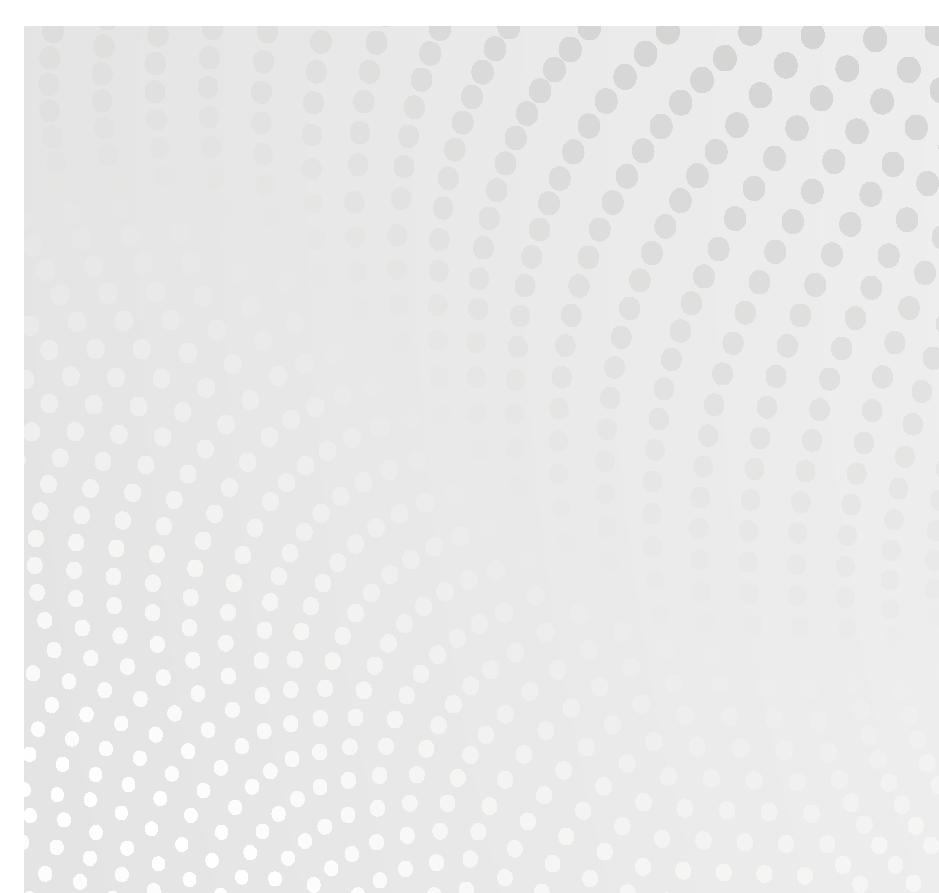
At Advanced Orthopedics Institute we specialize in hips, knees, shoulders, ankles, wrists...and kayakers.

We’re national leaders in reverse shoulder replacements for those whose rotator cuffs are no longer functioning, performing more in a year than most surgeons perform in a lifetime. We also have a full range of non-invasive procedures to help relieve shoulder pain and improve function.
Return to the activities you enjoy most.


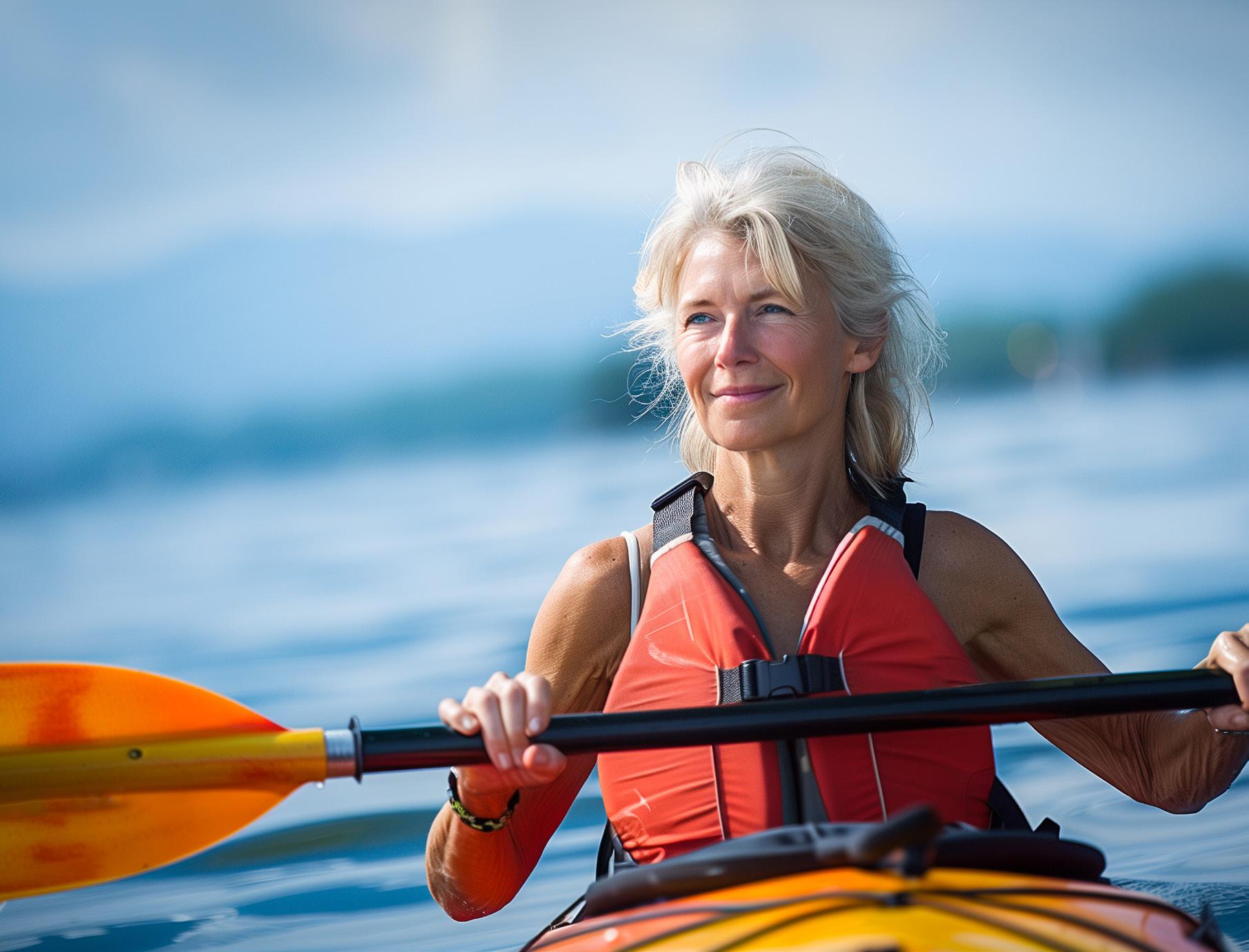


ALFREDJ.COOK,JR.,MD



For all of our advanced technologies and leading edge breakthroughs in joint repair and replacement, the advancements we at AOI are most proud of are those that our patients make in reclaiming their quality of life. If you are experiencing pain or weakness in a knee, shoulder, or hip and feel it’s time to do something about it, there’s no time like right now.
COME SEE US, WE’RE HERE FOR YOU.
1400 N US Hwy 441, Suite 552, The Villages, FL 32159
phone 352.751.2862 | fax 855.420.1047
go a o i .com

The passage of The Infl ation Reduction Act on August 16, 2022 requires the Centers for Medicare and Medicaid Services (CMS) to make signifi cant changes to Part D, impacting how much Medicare Benefi ciaries pay for their medications starting in January of 2025. The HIRA team is working diligently to understand the fi ner points of these new rules and communicate the potential impact to our clients. Since this is a change at the Federal level, everyone will be a ected no matter which carrier you have your drug coverage through.
BELOW IS A HELPFUL RECAP FROM THE CMS.GOV WEBSITE:
Annual deductible. The enrollee pays 100% of their gross covered prescription drug costs (GCPDC) until the deductible of $590 for CY 2025 is met.
Initial coverage. The enrollee pays 25% coinsurance for covered Part D drugs. The sponsor typically pays 65% of the cost of applicable drugs and 75% of the cost of all other covered Part D drugs. The manufacturer, through the Discount Program, typically covers 10% of the cost of applicable drugs. This phase ends when the enrollee has reached the
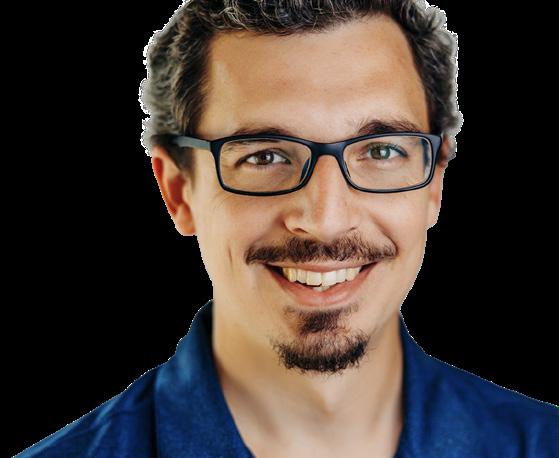
annual OOP threshold of $2,000 for CY 2025.
Catastrophic. The enrollee pays no cost sharing for covered Part D drugs. Sponsors typically pay 60% of the costs of all covered Part D drugs. The manufacturer pays a discount, typically equal to 20%, for applicable drugs. CMS pays a reinsurance subsidy equal to 20% of the costs of applicable drugs and equivalent to 40% of the costs of all other covered Part D drugs that are not applicable drugs.
https://www.cms.gov/newsroom/ fact-sheets/final-cy-2025part-d-redesign-programinstructions-fact-sheet
While we do not currently know how these changes will be refl ected in actual plan designs, that information will be available and can be discussed after October 1, 2024.
OUR MESSAGE TO EVERYONE THIS YEAR IS:
Read your Annual Notice of Change (ANOC)! Medicare plans are required to send out these documents in September each year outlining what changes you can expect the following year.
Be mindful of who you discuss your Medicare coverage with! Change can be stressful, which can make you more vulnerable to unscrupulous people trying to change your plan for the wrong reasons.
If you do not already have a trusted agent, the team at HIRA is standing by to Make Medicare Easy! Give us a call!


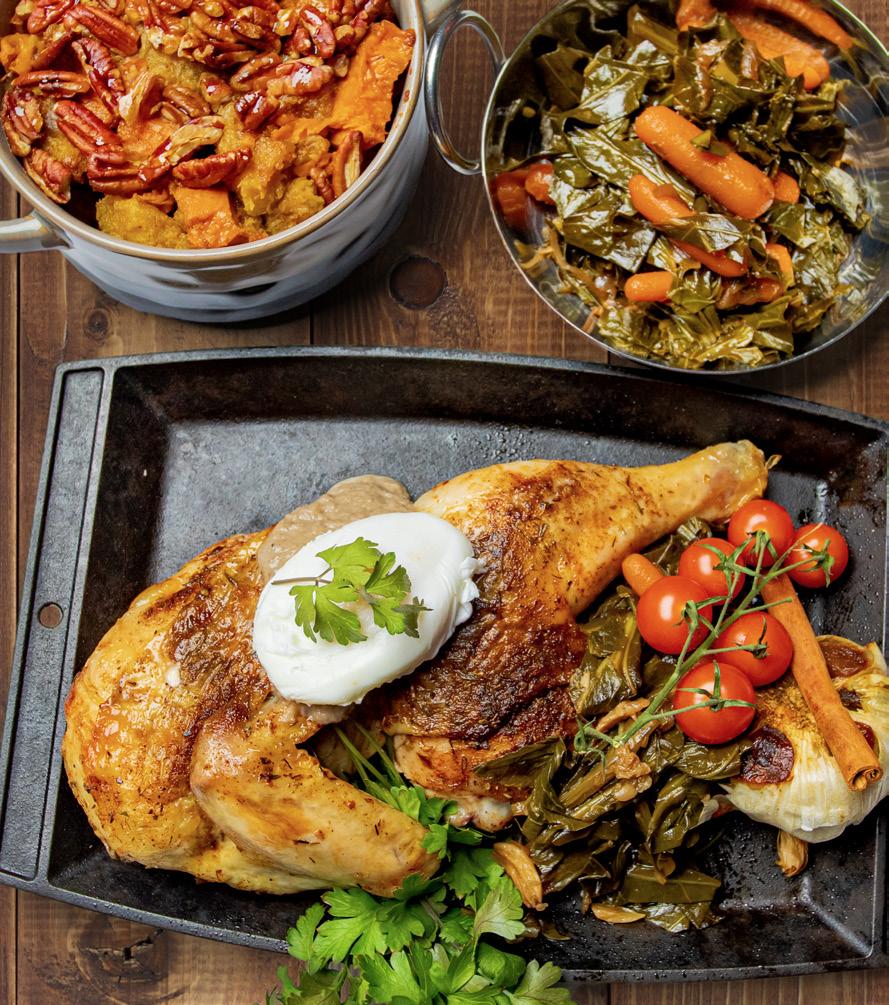
Autumn’s rich flavors elevate comfort food with seasonal flair! See recipes inside.


It’s pumpkin spice, apple pie and gingerbread cookie time! Pumpkin, apples, squash and cranberries combined with nutmeg, cinnamon, ginger and sage give us the rich flavors of the autumn season. When you use the ingredients and spices of the fall flavor palate below, you lose the fat and calories of this everyday comfort meal.
Use a young chicken that is pastureraised because of size and tenderness.
1
SEASONING BLEND:
1 tsp.
½ tsp.
½ tsp.
½ tsp.
¼ tsp.
½ tsp.
½ tsp.
½ tsp.
½ tsp.
½ tsp.
2-3


chicken, 5 lbs. or less dry thyme black pepper smoked paprika ground cardamom ground all-spice pink sea salt granulated onion granulated garlic dry sage dry oregano spritzes canola oil
You must split the chicken in half, or have your butcher split the bird for you. Place the chicken on a clean cutting board. Pat both sides with paper towels until dry. Slide your fingers under the skin over the breast to separate. Sprinkle seasoning blend generously over the meat under the skin. Season the rest of the bird on both sides with remaining seasoning. It is best to do so at least a couple of hours before cooking. Take the chicken out of the refrigerator at least 45 minutes before you plan to start cooking it. This will help the internal temperature of the chicken level o , so it doesn’t take as long for the center to reach desired temperature.
Preheat oven to 425 degrees. Place cast iron skillet in oven for up to 30 minutes. Remove pan and place on heat proof surface. Spritz the surface with canola oil a few times (Canola oil has a higher smoke point than other oils). Add the two halves of chicken, skin side down, and press down to make sure all the exposed surface area is touching the hot pan. Cook in the oven for 15 minutes. Flip chicken over and continue cooking for 10 to 15 more minutes. The chicken is done when the internal temperature reaches 155 degrees. Take out of oven and let the chicken rest for at least 20 minutes slightly covered to let the internal juices redistribute. At this point you can remove skin to cut down on fat intake and calories.
Add 2 cups of water to a 2-quart pot and put over medium heat to boil. When the water reaches a slow boil (about 200 degrees) add one tablespoon of white vinegar to help the egg whites coagulate faster and hold their shape. First, crack egg into small bowl or cup. Then, create a vortex (take a spoon and spin in the water in a clockwise motion) in the boiling water before adding Gently drop the egg into the center of the vortex. Let water return to a simmer and cook approximately 2 minutes. Using a slotted spoon, place the egg on a folded paper towel to drain completely. Keep warm.
MUSHROOM SAUCE
white button mushrooms or baby Bellas sliced 1/4 inch thick small shallot, minced dry white wine ground cinnamon granulated onion dry thyme vegetable stock (preferably low sodium) chopped fresh parsley (optional) eggs vinegar or lemon juice

Pre-heat a small saucepan on medium heat. Place oil and then mushrooms and cook until mushrooms are golden (They cook o all their water and concentrate flavor.) Add shallots and cook until translucent. Add wine and dry herbs and cook until almost dry. Then add vegetable stock and bring to a simmer. Simmer for 15 minutes and then let cool for 1 hour. Blend the mixture in a small blender until homogenous. Add fresh chopped parsley. Keep warm.
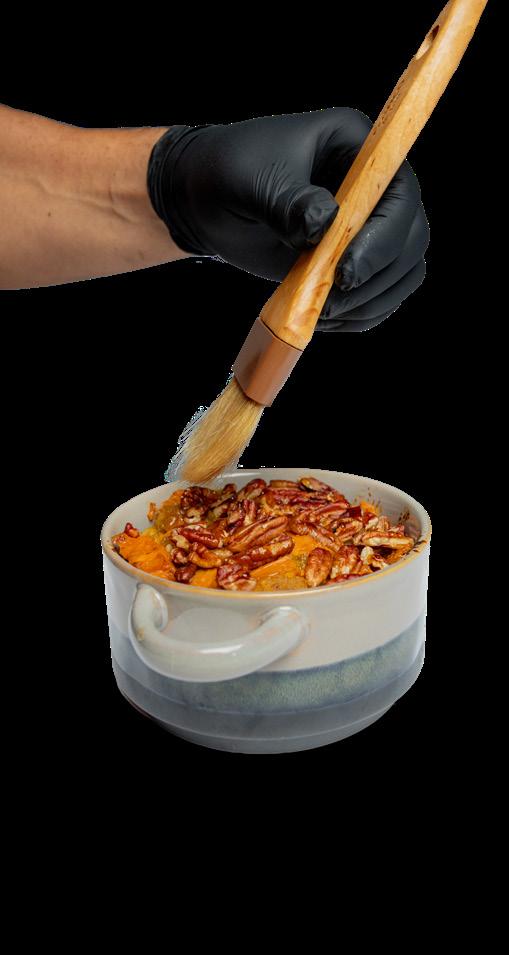
Tbsp. 2 Tbsp.
pecans, whole pecan pieces

head of garlic 1
Pre-heat oven to 375 degrees. Trim the top of the garlic head to expose the cloves inside. Place the head, cut side down on a lined baking sheet and bake for 25 minutes, or until golden brown. Let rest and cool. Squeeze the head to extrude the garlic cloves.


“Adding nuts to dishes not only adds flavor and texture, but it adds healthy fats and protein, as well. Try using other nuts such as almonds, pistachios and walnuts for alternative taste profiles and eating experience.”
Pre-heat oven to 375 degrees. Cut acorn squash and sweet potato in half, spritz with olive oil, and place on a lined baking pan. Bake for about 35 to 40 minutes until tender. Let cool so they are easy to handle. Peel the skin o the acorn squash, dice into 1/4-inch pieces and place in a small casserole dish. Make small cuts around the edge of the skin between the skin and flesh of sweet potato, dice into 1/4-inch pieces and add to the acorn squash. Drizzle with maple syrup, sprinkle with the clove and all-spice, top with pecans and bake for 20 minutes until the pecans are toasted. Serve hotttttt!
1 cup
1 Tbsp.
2 Tbsp. 6-8 ¼ tsp.
canola or avocado oil
(Your favorite neutral oil is acceptable)
small red onion, cut in half first then sliced very thin head roasted garlic, cloves squeezed out your favorite stock
(can be vegetable or chicken, preferably low sodium) collard greens, ribs removed, cut into 1/2 inch strips width wise baby carrots balsamic vinegar honey
dashes of your favorite hot sauce ground ginger grind of fresh black pepper is optional to taste
Add neutral cooking oil and onions to 8-quart pot over medium heat. When onions begin to caramelize, add the roasted garlic cloves and the carrots. Continue cooking until carrots start to caramelize and get some color. Then, add vegetable stock and bring to a simmer. Add honey, hot sauce, ginger, balsamic vinegar. Add the greens and let the broth steam and reduce the volume of the greens. Let the greens cook on low heat for 25 to 30 minutes until carrots are tender. Serve warm with some of the braising liquid.


pieces leaving the breast meat on the bone. Shingle the chicken over the collards. Drizzle mushroom sauce over chicken generously, then gently add poached eggs on top. Serve immediately with casserole in its own vessel on a trivet.
Comp Dish will be your standard herb roasted chicken pick up from a Sam’s Club, a mashed potato with no butter or cream and a standard coleslaw.
Entree Items/ 1 serving size/1/4 chicken/ cup of potato/ 1/2 cup of vegetable / 2 tablespoons sauce
Sodium(mg)
Calories
Fat (g)
Protein(g)
Cholesterol(mg)
Cast Iron Chicken/ egg/sauce/ Skin Removed/ Sweet potato casserole/Braised collard greens
(mg)
• Sodium content
Sam’s Roasted Chicken Mashed Potatoes/Gravy/ Coleslaw
• Removal of the skin after cooking to contain less saturated fats.
• Sizing and quality of the chicken choices
• The sauce will be lower in fat and sodium.
• The addition of a poached egg with added protein
• A family style side dish that is healthier and tastier than the average mashed potato or potato Side dish and fits the seasonality.
• The underutilization of healthy greens
• Use of spices that are readily available year-round that can add a new twist to your local sourced ingredients and allow you to be creative and show all your positive energies through your dishes.
LOUIS SANTIAGO

The Harvest Apple Mule is a refreshing, non-alcoholic cocktail perfect for autumn. It blends the crispness of apple cider with the zest of lemon and the spice of ginger beer, enhanced by the deep, earthy flavors of aromatic bitters. This drink is not only delicious but also adds a functional health benefit, supporting digestion and liver health.
apple cider
lemon juice
ginger beer
dashes All The Bitter Aromatic bitters
Garnish: Cinnamon stick and apple slice
Add Ingredients: In a glass or copper mug filled with ice, add apple cider, lemon juice, ginger beer, and aromatic bitters. Stir gently to mix the ingredients while keeping the fizz. Garnish with a cinnamon stick and an apple slice for a festive look.

Crafting drinks that elevate moments without the need for alcohol, Taylor Boyd helps redefine what a cocktail can be, designing each creation to enhance well-being and celebrate the art of the drink. Taylor is a veteran mixologist and owner/operator of “Refind” Alcohol-Free Bar (Bartender Rental LLC).
EDITORIAL@AKERSMEDIAGROUP.COM
Louis Santiago is the chef and owner of Chef’s Concept Kitchen, located at Ageless Beauty Med Spa in Leesburg. He has been in the culinary field since 1997 and in the community since 2000. He worked for the Morse family of The Villages®, opening numerous country clubs for them, most notably Cane Garden Country Club, where he was a chef for more than 14 years.

Infrared therapy uses light and heat to provide health benefits.
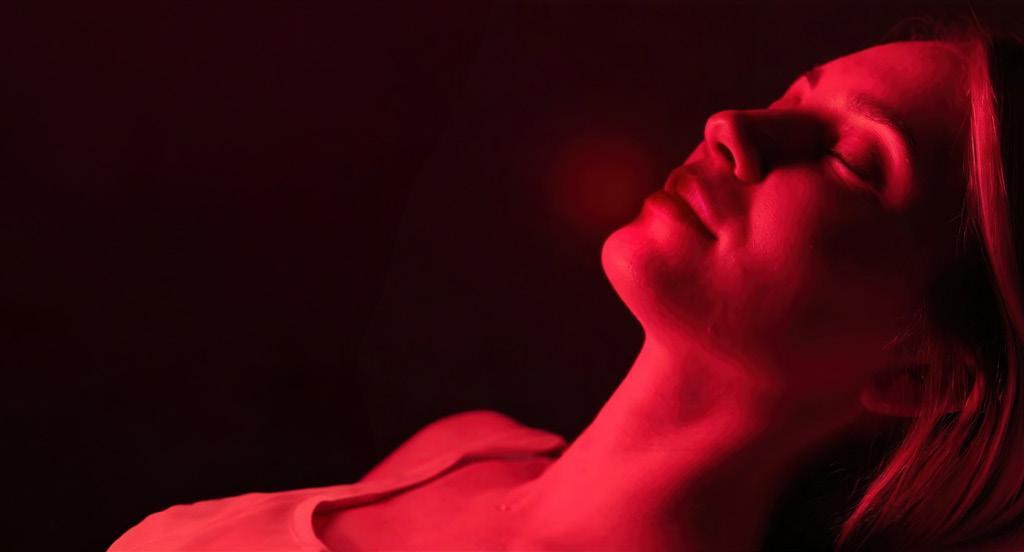

Sometimes what you can’t see can help you.
That’s definitely the case with infrared therapy in the form of both light and heat.
Our eyes can’t see infrared light because its longer wavelength puts it outside the spectrum of vision, yet the benefits of infrared therapy are widespread and becoming more popular. Infrared therapy o ers natural, drug-free and chemicalfree options for improving health and wellbeing. It may even help you look younger and feel better.
We’re routinely advised to avoid ultraviolet light because it can damage skin over time. Yet infrared and red light therapy are shown to repair sun damage, reduce wrinkles and build collagen.
Although infrared light is invisible, red light is visible. Many red light therapy systems use small amounts of infrared in combination with red LED lights.
“Red light is considered lowinfrared. It penetrates the body to perform intra-cellular repair and helps the healing process. It’s one
of our most popular treatments. You feel the benefits from it,” notes Sabrina Ciceri of Immunity Health in The Villages.
Immunity Health has a red light, TheraLight 360 bed that utilizes red and near-infrared light. This FDAapproved technology is also known as Photobiomodulation Therapy (PBMT). Benefits include:
• Pain relief
• Reduced inflammation
• Relief of joint pain and sti ness
• Improved muscle performance and recovery
• Cell repair and detox
• Increased circulation
• Supports immune function
• Decreased hair loss
• Wrinkle reduction
• Builds collagen
• Repairs sun damage
• Fades scars
Research has shown that red light therapy can e ectively treat hair loss caused by the genetic disorder androgenic alopecia. Studies show it can also help relieve pain of rheumatoid arthritis and help those with dementia be less angry and sleep better.
Multiple celebrities promote red light therapy to reverse aging.
“Most clients come to reduce pain and inflammation in the body and for healing,” says Sabrina, adding that it’s especially helpful post-surgery. “It rapidly increases the healing of wounds and not just on the surface. Because it opens up detox pathways, it also helps eliminate all anesthesia from the body.”
For maximum benefit, Sabrina recommends at least three 20-minute sessions of red light therapy, or ideally, 10 sessions. Red light therapy is safe to use daily if you choose.
“Whether you come in and do a 45,000 light therapy full body, or you order a 1,000 light panel online, any red light you can get is beneficial— the more the better,” Sabrina says.
While eye protection isn't necessary during red light therapy, it's best to avoid looking directly at the LEDs. For added comfort, close your eyes during the treatment session, or, if sensitive to red light, ask your provider for protection.

Infrared heat is easily absorbed by the body and causes you to sweat, making this a natural detoxification method to eliminate toxins. This healing light energy is also used to help slow aging and optimize well-being.
Unlike traditional saunas which are typically 180 to 210 degrees, infrared saunas usually operate between 110 and 140 degrees.
At Renew Day Spa in Leesburg, owners Tim and Dina Simpson say that the majority of their clients are looking for detoxification and pain relief. Renew Day Spa uses the Sunlighten mPulse, a 3-in-1 full spectrum infrared sauna.
Heating the body from the inside out in an infrared sauna has multiple benefits, including:
• Detoxification
• Pain relief
• Increased circulation
• Lower inflammation
• Increased metabolism
• Improved sleep
• Improved skin tone
• Boosts immune system
• Promotes relaxation
• Promotes weight loss
“It has also helped people who are trying to quit smoking and cancer patients after chemo treatment,” Tim says.
Because it raises the heart rate, an infrared sauna session is like a passive cardio workout. Some clients burn as much as 600 calories in one session, which can help with weight loss.
Each 30- to 45-minute session uses infrared elements to increase the body’s core temperature. Dina says that the sauna’s settings can be adjusted, depending on which goals are most important for each client.
Maximum skin exposure to the infrared heat is advisable. Showering is recommended right after a sauna session to eliminate
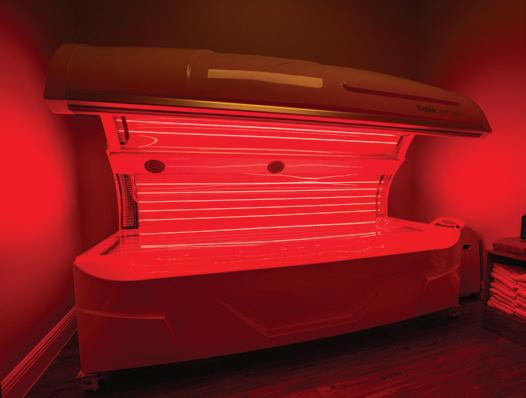
CYNTHIA MCFARLAND EDITORIAL@AKERSMEDIAGROUP.COM
any toxins in the sweat from being reabsorbed.
Many clients use the infrared sauna weekly, but there’s no drawback to using it daily.
While there are no known dangers to using the sauna as a therapy, there might be adverse e ects for someone with heart disease or blood pressure issues. Consult your doctor before using an infrared sauna.
Infrared sauna use is not advised for pregnant women or anyone with an implanted medical device like a pacemaker.
A few minutes of online shopping can provide the convenience of infrared therapy at home.
For under $100, you can order a red light therapy mask on amazon.com. For less than $250 you can purchase a portable infrared one-person sauna. Check the ratings and read reviews before ordering.
Immunity
833.484.6348
ImmunityHealth.com

Renew Day Spa
352.787.7722
RenewDaySpa.org
“I fell in love with words early on and knew from fourth grade that I wanted to be a writer,” says Cynthia McFarland. A full-time freelancer since 1993 and the author of nine non-fiction books, her writing has earned regional and national awards. Cynthia lives on a small farm north of Ocala; her kids have fur and four legs.

STORY: DR. CRAIG CURTIS

You’ve probably heard of Alzheimer’s disease, a condition currently a ecting nearly 7 million Americans. If we don't find a cure, this number could rise to almost 13 million by 2050. Alzheimer’s disease damages brain cells, known as neurons, through a degenerative process involving sticky deposits. These deposits impair surrounding brain cells, leading to memory loss and other symptoms.
Recent research suggests that we might be able to make our brains more resilient to Alzheimer’s disease through positive lifestyle changes. Scientists are exploring the concept of "cognitive reserve," which is the brain's ability to remain sharp and healthy despite the onset of Alzheimer’s.
A recent trial found that lifestyle changes helped some individuals with early memory loss manage the e ects of Alzheimer’s. While the study was small and not everyone benefited, some participants showed remarkable improvements.
CRAIG CURTIS
Eat Properly: A diet rich in whole grains, fresh fruits, vegetables, and lean proteins can improve overall health and reduce the risk of dementia. An essential component of a healthy diet is extra-virgin olive oil. A March 2024 study from Harvard Medical School found that consuming about 1.5 teaspoons of olive oil daily was linked to a 28% reduction in dementia risk. The benefits may stem from polyphenols—plant nutrients with antioxidant properties that support blood vessel health, improve circulation, reduce inflammation, control blood sugar, lower cancer risk, and boost immunity. Over 8,000 types of polyphenols are found in fruits, vegetables, nuts, and seeds. The MIND diet (Mediterranean-DASH Diet Intervention for Neurodegenerative Delay) has also been shown to slow memory loss, reduce Alzheimer’s risk, decrease brain shrinkage by up to 70%, and lead to less brain damage.
Exercise More: Increasing physical activity has similar cognitive benefits to following the MIND diet. Studies show that 30 minutes of moderate to intense exercise per week can enhance brain function and even increase brain size. Consult your physician before starting or intensifying any exercise regimen to ensure it’s appropriate for you.
Get Adequate Sleep and Lower Stress Levels: While space doesn’t permit an indepth discussion, managing stress and ensuring su cient sleep is crucial for brain health. For more information, consider attending one of my seminars.
By integrating these lifestyle changes, you can strengthen your brain and potentially reduce the risk of Alzheimer's disease.
Dr. Curtis serves as Chief Medical O cer and founder of K2 Medical Research- The Villages. He has been involved in clinical research, primarily focused on the prevention and treatment of Alzheimer’s disease, since 1998 and is one of the most experienced research medical doctors in the country.





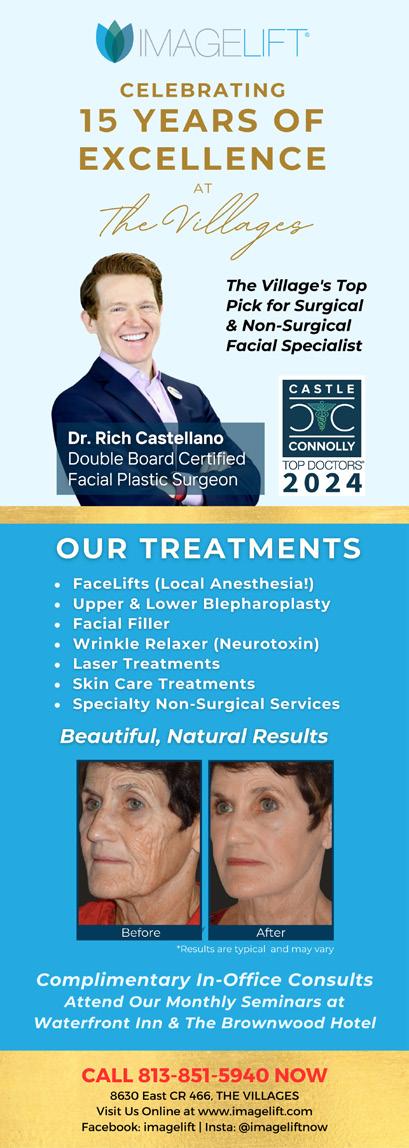
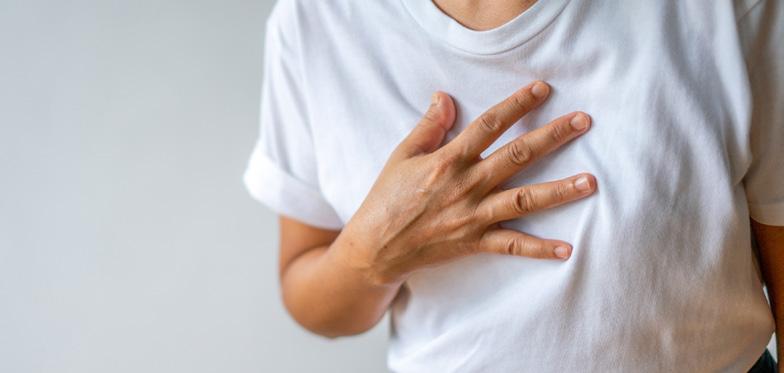
We know emergencies can happen anytime, anywhere. With 14 ER locations throughout Central Florida, we’re ready to provide expert emergency care 24/7. Giving you more reasons to choose well. OrlandoHealth.com/ER 1900 Don Wickham Dr. | Clermont, FL 34711












The human impact of leading-edge science.


odern medical science keeps bringing us closer to treatments and cures we need to live a healthy life — reversing disease-causing genetic mutations by altering DNA, removing and replacing vital organs and rebuilding neurological connections in the brain.
To most of us, such advances are just jargon, but six local residents know first-hand how medical science miraculously relieves human su ering. Their stories illustrate the impact of recent medical breakthroughs on real people living in our community.




In January 2023, Lake County resident Danny Sam received a double lung transplant, a medical procedure he considers a miracle. That’s not surprising considering that a matched donor became available when he needed two new lungs. A double lung transplant sounds like some space-age medical miracle, but the surgery has been around for the last three decades.
DANNY SAM
breathes for him while the surgeons remove and replace each lung, one at
According to Dr. Emtiazjoo, a key element to a successful lung transplant is having a team that works together harmoniously and e ectively with the patient to make the
Approximately 74 U.S. hospitals can perform a double lung transplant with varying levels
expertise because they handle a larger volume and more complex cases, which allows sta to improve their skills.
“At UF Health Shands, we do between 50 and 100 lung transplants a year compared to some other programs that only do 10 or 20,” Jamie says.
There are several conditions a patient must meet. First and foremost: a willingness to exercise regularly and make healthy dietary changes.
“The actual miracle is not the procedure itself but the fact that we’ve improved the technique to make transplant a viable option for a broader range of patients,” explains Dr. Amir Emtiazjoo, UF Health Shands Lung Transplant Program medical director.
The procedure is actually quite similar to a single lung transplant performed twice. The patient is put on a machine that temporarily
“It’s about the expertise of the whole hospital, from the pre-care coordination to surgery to intensive care recovery and carrying on to post-care coordination,” explains Jamie Burrows, BSN, CCRN-K, UF Health Shands Lung Transplant Program manager.
The operation is the crucial part, but patient selection and post-operative care are important for the best outcome.
“You need the whole orchestra, not just the piano,” Dr. Emtiazjoo says.
Lung transplant programs like the one at UF Health Shands can o er a higher level of
A prospective lung transplant patient might be disqualified if he or she is an active smoker, is severely debilitated or does not have a strong care provider plan for support throughout the process and follow-up.
On March 1, 2023, Danny walked out of UF Health Shands under his own power with his new lungs, forever grateful for the transplant team and for the medical breakthrough of a double lung transplant.
To learn more about the lung transplant program at UF Health Shands, visit their website: https:// ufhealth.org/conditionsand-treatments/ lung-transplant.

ou probably think of chemotherapy when you hear about cancer treatment. That was Bob Tracey’s first thought when he was diagnosed with chronic lymphocytic leukemia (CLL) in 2017. His second thought was an image burned into his brain of his father-inlaw, a thin, pale, almost ghost-like version of himself trying to survive chemo and beat cancer.
When Bob was diagnosed with CLL, his doctor tried to soften the news by telling him and his wife, Ann, that the disease was no big deal, that they could control the disease and Bob would be fine.
Bob wasn’t buying it.
“I looked at Ann and asked what her father died of, although I already knew,” Bob says.
In front of the doctor, in that tense moment, Ann articulated Bob’s concerns. When her father received his diagnosis, the doctors said it was no big deal, but he died a year later after an agonizing attempt at treatment.
For Bob, immunotherapy was the medical breakthrough that kept him from repeating his father-inlaw's fate.
CLL, the most common form of leukemia in adults, is a blood cancer that begins in the bone marrow. Immunotherapy has replaced chemotherapy as the most e ective treatment for blood cancers such as CLL.
“Bob didn’t get chemotherapy—the stu that makes you lose your hair,” explains Dr. Maen Hussein, oncologist at Florida Cancer Specialists. “Oncology is evolving very
fast. We’re having much better outcomes and far fewer side e ects with immunotherapies.”
The chemotherapy used to treat CLL was highly
Bob had, stimulate the immune system to fight the cancer. They can target and block specific proteins the cancer cells require to grow and multiply, thereby

JANE MASTERSON
In January, the Food and Drug Administration (FDA) approved the latest version deep brain stimulation (DBS) device for Parkinson’s. Although DBS is not a new treatment, recent improvements to the device bring added convenience to people living with Parkinson’s, along with more information-gathering capacity for medical scientists still looking for a cure for the disease.
And although Parkinson’s comes with a wide range of symptoms, tremors may be one of the most common.
People living with Parkinson’s, like Jane Masterson of The Villages, often develop tremors that keep them from performing daily activities like signing their name, writing a grocery list, pouring a cup of tea, feeding themselves and managing their own self-care.
Jane was diagnosed with Parkinson’s in 1997 and had her first DBS implant in 2010 to control significant tremors on the left side of her body.
“Like magic, the tremors went away,” says Jane, co-author of the book Our Parkinson’s Disease Instruction Manual. A year later, she had another DBS implant in the left side of her brain to manage right-side tremors.
Jane refers to her two brain surgeries as if they were no
big deal. In fact, each implant required surgeons to shave her head and cut into her skull to insert an electrode in just the right spot.
“My head healed, and my hair grew back. It was important to me to stop the tremors so I could be more independent again,” Jane explains.
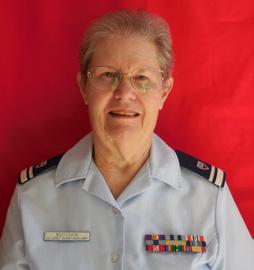

The DBS device sits beneath the skin just below the collarbone and is attached by fine wires that run under the skin to the electrode deep inside her brain.
But brain surgery was not the end of the process. Programming began once Jane recovered from surgery. A neurology technician adjusted the DBS controller and Jane went home to see how they worked. There were several trips back and forth to get the individual settings right and maintain optimal functioning.
After 10 years of managing her tremors, Jane’s initial DBS device was turned o because it developed a defect that would require surgery to repair. Unfortunately, replacing the DBS wasn’t an option.
Fourteen years after her first brain surgery, Jane’s health has
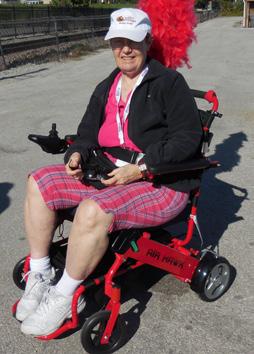
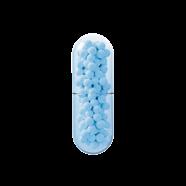
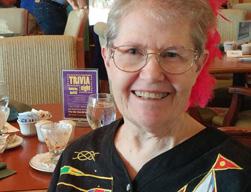
declined and anesthesia is no longer an option.

Jane still benefi ts from her other DBS, which can be reprogrammed to keep up with her changing condition.
“That’s one of the hallmarks of this disease is that it’s always changing,” Jane explains. “You might control the symptoms for a time, but they will be back and other symptoms will develop.”
Jane knew the day would come. It does for everyone living with Parkinson’s.
“My suggestion to anyone considering DBS for Parkinson’s is to not wait until your tremors are severe because eventually you will no longer be a candidate for surgery,” Jane shares.
Jane may be out of options today, but tomorrow could bring the next breakthrough. Medical science is always changing in an e ort to keep up and one day get in front of neurological conditions like Parkinson’s.
The latest version of the DBS device, Medtronics Percept includes a 15-year battery that recharges in an hour. That’s a convenient upgrade from the 5-year batteries used in Jane’s devices. The Medtronics Percept, can also be programmed remotely, eliminating many trips to the medical o ce.
Perhaps the most promising part of this new device is the inclusion of BrainSense technology, which captures and records brain signals. Neurologists no longer have to rely on information from the patient to program the device for optimal functioning. They can use the recorded data to personalize DBS therapy.
JOHN ROSENWINKEL
In March, stroke survivor John Rosenwinkel traveled to Tampa General Hospital to have a device implanted just under his collarbone and wired to the side of his neck.
The Vivistim device stimulates the vagus nerve during therapy exercises to boost the brain’s neural activity and helps build new neuropathways for controlling arm and hand movement.
This medical breakthrough is a game-changer for victims of stroke, the leading cause of death in the U.S. according to the Center for Disease Control and the leading cause of disability according to the American Stroke Association.
During a stroke, the brain is damaged when blood flow is interrupted and brain cells are deprived of oxygen. Those who survive a stroke are often left with partial paralysis, an inability to speak, chronic pain, memory loss, anxiety and depression.
Depending on the extent of the damage, some abilities lost may be recovered in the first several months after the stroke. But recovery generally hits a plateau. To move past this recovery plateau, the brain needs to build new neural pathways, an ability called neuroplasticity.
John remained on that plateau for five years before learning about the new device reported to increase neuroplasticity for stroke
survivors with diminished upper extremity functioning.
In John’s case, the Vivistim was activated by his physical therapist via remote control during six weeks of in-clinic rehabilitation. For athome exercises between therapy sessions, John activated the Vivistim with a magnet.
Therapy activities are customized to the patient’s abilities and goals. Stimulating the vagus nerve while performing repetitive motions helps build neuropathways faster than regular physical therapy. Adding 30-minute sessions of home exercise further speeds improvement.
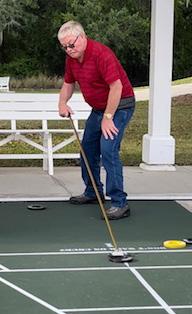
With the help of Vivistim, patients with limited arm and hand movement due to a stroke are again able to participate in daily living activities like showering, cooking meals, buttoning their shirts or playing cards.
We had a patient who wanted to mow his lawn again, and one who wanted to be able to cast his fishing rod,” says Terri Stemple, territory manager for MicroTransponder, the manufacturer of Vivistim.
“We had a patient recently who could not pick up a pen, and at the end of six weeks of therapy he wrote me a birthday card and signed his name.”
In just a few months following the implant, John went from
STEVE NEGEN
having little functionality in his right hand to cutting his own meat and clipping his fi ngernails by himself.
“He can even drive with his right hand and write a little, and he’s still improving,” Sue, John’s wife, explains. “All in all, we're very happy with the device. People that haven't seen him in a while can really see his progress.”
Ideal candidates for Vivistim Therapy are ischemic stroke survivors with chronic upper limb motor deficiencies who are healthy enough for surgery and have enough motor control to participate in physical therapy. For more information, go to vivistim.com.
Steve Negen is using the latest version of the Watchman to get o the blood thinners he’s taken for the last 15 years. Living without that medication will open a whole new world of possibilities for Steve.
The Watchman, a permanent implant designed to close the left atrial appendage in the heart, was originally approved by the Food and Drug Administration (FDA) in 2015 as an alternative to blood thinners for reducing the risk of stroke.
Steve’s heart troubles began in 2009 when he survived a heart attack likely brought on by an allergic reaction to medication he
thinners for four days,” Steve says. “There’s no telling what could happen in those four days.”
Blood clots often form in that left atrial appendage, a small side compartment of the heart. By closing o this compartment, the Watchman prevents clots from forming.
The latest version of the Watchman, the Watchman FLX, includes upgrades like a new polymer coating that reduces the risk of blood clots forming around the device and enables faster healing from the procedure. New markers on the device make it easier to see and implant in exactly the right location. The Watchman FLX is also available in a wider range of sizes that allow the right fit for more patients.

“The biggest improvement in this latest version Watchman is in the safety profile,” says Dr. Gregory O. von Mering, who performed the Watchman procedure at HCA Florida Heart and Lung in Ocala. “The new coating on the outside of the device facilitates the growth of tissue over the device without risk of forming clots.”
received during a stent procedure. Ten years later, he had a stroke a couple months after neck surgery.
Stroke victims are often prescribed blood thinners because they keep blood cells from sticking together and forming clots that can cause heart attack, stroke, or pulmonary embolism.
But blood thinners have their drawbacks. One of the more serious side e ects of blood thinners is excessive bleeding because the blood doesn’t clot easily. That can make medical procedures risky.
“Every time I have a procedure, like my colonoscopy next week, I have to stop taking the blood
Steve is understandably anxious about another heart attack or stroke since he’s experienced both and therefore may be at a higher risk of developing a blood clot. Since his stroke, Steve is not steady on his feet, making him a fall risk. Any time he bumps into something, Steve bruises right away.
“The Watchman is essential to patients like Steve who don’t tolerate blood thinners well. Before the Watchman came along, there was no alternative treatment,” Dr. von Mering explains.
Steve is looking forward to putting the risk and cost of blood thinners behind him. And as he looks forward, beyond the Watchman, he is hopeful to be a candidate for Vivistim so he can continue his stroke recovery.

BILL MCKINNEY

f you ask Pokhui McKinney to name the most significant medical breakthrough of this decade, she’ll tell you about the Duopa that allowed her husband to walk again.
Pokhui knew something was wrong when she noticed her husband Bill walking without moving his left arm. Bill, a career military man who had spent a couple years in Vietnam and was exposed to Agent Orange, was diagnosed with Parkinson’s in 2008.
Ten years later, Bill was retired from the military and working a civilian job when his tremors got so bad that he could not stand still to make the presentations his job required. He had to resign. In 2020, a bout of COVID accelerated Bill’s Parkinson’s symptoms and he could no longer walk.
The medication could not keep up with Bill’s accelerated symptoms, as often happens in advanced Parkinson’s. Bill was taking 18 pills a day at extremely high doses, but his tremors were not under control.
“With the tremors on his left side, and dragging his left leg, Bill had some spectacular falls, on planes, in church. He fell in the washroom and broke his right femur neck,” Pokhui explains.
Today, Bill no longer takes any pills for Parkinson’s, and he walks without a walker or a cane. The di erence is Duopa.
Duopa is a delivery system for Parkinson’s medications that bypasses the digestive system and goes directly into the small intestine. Duopa, which is administered in gel form every three to four seconds consistently throughout the day, provides better results than pills that are broken down in the stomach and absorbed into the blood stream at varying rates.
A PEG-J tube implanted in Bill’s abdomen provides a direct line to his intestine. The tube runs externally to a pump that is programmed for his specific needs. The medication is
contained in a cassette that is plugged into the pump.
Bill was admitted to the hospital for the PEG-J tube, though it is usually done as an outpatient procedure. Dr. Robert Hawes from Orlando Health Endoscopy made sure Bill’s tube was positioned correctly.
On July 16, Bill went to the Parkinson’s Foundation Center of Excellence in the Fixel Institute in Gainesville to have the Duopa pump attached to the J-tube and programmed. Results came almost immediately.
“Bill could barely walk with his walker, but when we came back from lunch he was walking on his own,” Pokhui said.
Exercise and routine are the two most important elements to slowing the symptoms of Parkinson’s. Bill and Pokhui have a new morning routine with Doupa.
“I get up at 5:30 every morning and take a cassette out of the refrigerator to warm up. At 6, I connect the room temperature cassette to Bill’s pump,” Pokhui explains. “It takes about a minute. He’s usually still sleeping.”
Exercise is better for Bill now that he can walk without assistance. He still shu es a little, but he is much steadier on his feet than he used to be. Bill participates in the Power with Parkinson’s Fitness program at Genesis Health Club, where boxing is used for physical and mental fitness.
“I boxed when I was at West Point; I was regimental champion,” Bill says. “It’s great to be able to box again, at least in the gym.”
Bill and Pokhui know three other people who have the Duopa, and Bill’s results are more dramatic than theirs.
“Doupa is a miracle for Bill,” Pokhui exclaims.
Duopa is approved for people with Parkinson’s who experience three hours or more of “o ” time, when their tremors are not well-controlled, each day.

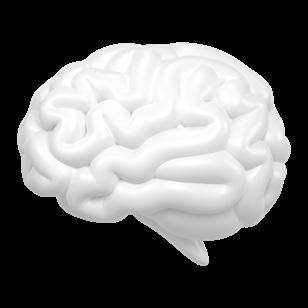
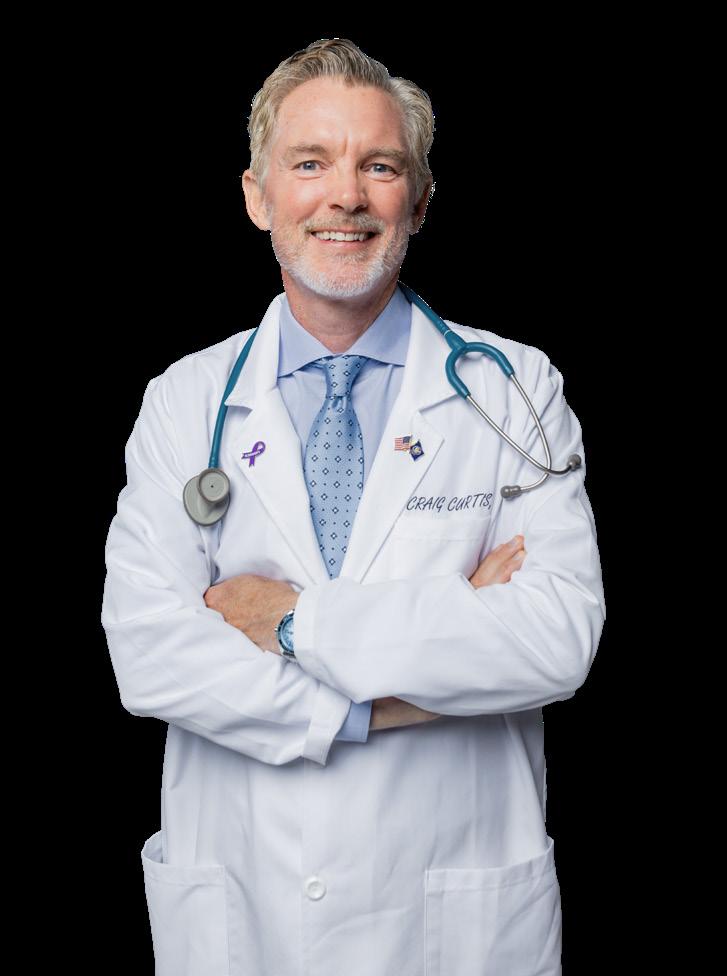
Participants who ate bacon, hot dogs, kielbasa, salami, bologna and other processed red meats were more likely to develop dementia.
“Processed red meat has also been shown to raise the risk of cancer, heart disease and diabetes. It may a ect the brain because it has high levels of harmful substances such as nitrates (preservatives) and sodium,” says Yuhan Li, MHS, lead author of the study.
Researchers also concluded that replacing a daily serving of processed red meat with a serving of non-meat protein source like nuts, beans or tofu, every day could reduce the risk of developing dementia by 20%.
dementia than study, reported at the Alzheimer’s Association
“Science is showing there are many lifestyle changes we can make to lessen our risk of Alzheimer’s, and this latest finding identifies another change you can start today,” says Craig Curtis, MD, founder of K2 Medical Research.
A blood test exhibited high diagnostic accuracy for detecting Alzheimer’s, according to a study published in the Journal of the American Medical Association at the end of July. The ability to
diagnose Alzheimer’s with a blood test could speed up the diagnostic process and alleviate long wait times to see specialists.
People are becoming more aware of the early signs of Alzheimer’s and overwhelming neurologists for appointments to begin the lengthy evaluation process. A blood test that can be administered by primary care physicians could help triage the flood of patients seeking evaluation and assuage the fears of many with mild cognitive issues not related to Alzheimer’s.
“Only a small portion of patients who get in to see a memory specialist need to be there. This new diagnostic tool can empower primary care physicians to make informed decisions about the need for specialist appointments,” Dr. Curtis says.
The Food and Drug Administration (FDA) have approved the first cell-based gene therapies for sickle cell disease, a medical breakthrough that represents the first real chance for a cure for many people living with this lifethreatening blood disease.
“Historically, allogeneic bone marrow transplant was the only potential cure. While this treatment is e ective, it requires the use of bone marrow from a compatible donor,” says Dr. Hany Elmariah, an associate member of the Blood and Marrow Transplant and Cellular Immunotherapy at Mo tt Cancer Center.
Sickle cell, the most commonly inherited blood disease, a ects about 100,000 Americans according to the Center for Disease Control (CDC), a majority
DR. HANY ELMARIAH

of whom are African American.
The disease is a protein mutation in red blood cells which limits oxygen delivery to the tissues, causing severe pain and organ damage and limiting life expectancy by up to 20 years.
“New gene therapies attack the underlying cause of sickle cell by reprogramming the patient’s own bone marrow so that it stops making sickle cells and starts making normal blood. Since it uses the patient’s own marrow, this treatment is feasible even for patients who do not have a compatible donor,” Dr. Elmariah explains.

Two newly-approved treatments — Casgevy and Lyfgenia — focus on altering stem cells and returning them to the body. Stem cells collected from the patient are genetically modified and then returned via infusion to stimulate the production of healthy red blood cells.
“It is still early to know how gene therapy will work in the real world. But the early studies have shown incredible results that will be life changing for our patients and hopefully paradigm shifting for how we treat sickle cell and other similar blood diseases,” Dr. Elmariah concludes.

The heart is a vital organ essential for pumping blood throughout the body, ensuring organs and tissues receive enough oxygen and nutrients to stay healthy and function properly. As part of the cardiovascular and circulatory system, maintaining heart health involves proactive measures to keep the heart muscle strong and healthy for a longer life.
Good heart health results from healthy eating, regular exercise, and routine medical check-ups to address potential issues early. These practices help prevent severe heart conditions.
According to the CDC, heart disease is the leading cause of death for both men and women, with one person dying every 36 seconds from the disease. The annual cost of managing heart conditions is about $219 billion. Heart disease encompasses more than heart attacks; it includes
coronary artery disease (CAD), heart infections, heart failure, angina, peripheral arterial disease (PAD), and more. Many of these conditions are manageable and not immediately life-threatening. However, maintaining heart health can reduce the risk of chronic conditions requiring long-term medication.
THREE KEY BENEFITS OF A HEALTHY HEART INCLUDE:
1. Lower Blood Pressure: Blood pressure measures the force of blood against artery walls. High blood pressure can damage organs, including the heart. Monitoring and maintaining a healthy blood pressure range (less than 120/80 mm Hg) reduces the risk of hypertension and heart failure.
2. Prevent High or Low Blood Sugar and Insulin Levels: Balanced blood
sugar levels are crucial for energy. High or low blood sugar can cause serious health issues. Diet plays a significant role in managing blood sugar. Consuming excessive sugar can lead to chronic conditions like diabetes, kidney failure, and heart disease.
3. Reduce the Risk of Heart Attacks: Proper blood flow to the heart is vital. Blockages from fat, cholesterol, or plaque can lead to heart attacks. Preventative measures, such as a healthy diet, regular exercise, and avoiding smoking and excessive alcohol, can reduce these risks. With expertise in several cardiac subspecialties and a state-of-theart facility equipped with advanced technology, the experienced and highly-trained providers at Lorven Heart & Cardiovascular Institute provide coordinated, comprehensive, and compassionate individualized care.
Lorven Heart and Vascular o ers comprehensive diagnostic and therapeutic cardiovascular services for our patients. Our board-certified cardiologists have extensive subspecialty training and experience, o ering state-of-the-art technologies allowing for a more personalized, ongoing evaluation and management of their cardiovascular care and needs. Most importantly, our team believes in personalized, caring and compassionate medicine.






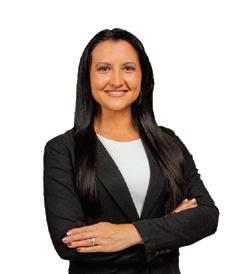

Discover how gratitude transforms challenges into opportunities for growth and positivity in daily life.

Have you ever had a nightmare after watching a scary movie?
It happened because your brain was still processing the emotions it created after the movie was over. If the movie was particularly haunting, you may have a few nightmares but after several days, you go back to sleeping soundly.
What if the nightmares continued for weeks or months, and the subject of them was not a movie but something you saw in real life?
What if it wasn’t just nightmares but also daydreams that disrupted your daily activities with debilitating fear, anxiety and panic?
You might be experiencing a response to trauma known as post-traumatic stress disorder (PTSD), which is more common than you might think.
Trauma is basically unprocessed emotions stuck in your brain. Each time something triggers you to remember the trauma, your brain goes through it again as if it were happening in the present. The more often your brain relives the trauma, the more severe the emotions can become, instead of fading over time.
Although PTSD is commonly associated with military service, anyone can develop it. According to the American Psychiatric Association, one out of every 11 people will be diagnosed with PTSD at some point in their life, and women are more likely than men to develop PTSD.
In PTSD, emotions reach an intensity where it is impossible to
talk about the traumatic incident. Just the thought of what happened brings up the brain’s defenses, expressed in symptoms like headaches, flashbacks, nausea and unpredictable emotions, and pushes you around that endless loop again.
Joyce Urban, LMHC at Urban Counseling in Ocala, experienced the e ects of PTSD for several years before she became a licensed mental health counselor and certified EMDR practitioner.
One day, Joyce got the call every parent fears; her daughters were in a serious accident.
Her daughters recovered, but the sight of the accident scene stuck in Joyce’s head along with the sick, panicky feeling that her daughters could have died that day. “For weeks after the accident, anytime I saw flashing lights or heard sirens, I would throw up,” Joyce says.
That’s when she discovered Eye Movement Desensitization and Reprocessing (EMDR). After just three sessions, Joyce was able to deal with her emotions and relegate the memory of the accident to a deeper place in her brain. “I will never forget what happened, but I can talk about it now without the intense surge of debilitating emotions,” Joyce explains.
It might seem like an unlikely connection, but lateral eye movement has a desensitizing e ect on negative emotions.
The EMDR Institute developed an EMDR treatment protocol and trains mental health professionals all over the world.
EMDR therapy uses the eye movement protocols in conjunction with traditional
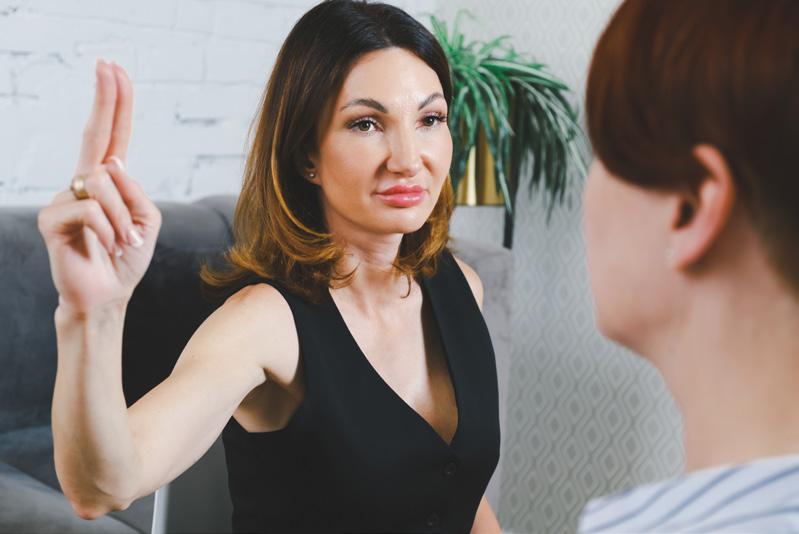
cognitive behavioral therapy, often referred to as talk therapy. EMDR is not a cure for PTSD; it simply makes it possible to work on the trauma and release the emotions.
Patients use visualization to establish a safe space where they can retreat to any time emotions become overwhelming. The eye movement part of the therapy has an almost immediate a ect to reduce the emotional response. Once the emotions are safely managed, the patient can more easily participate in the talk therapy portion of the treatment to address the trauma.
“I had a client who faced extreme anxiety about going to concerts and other crowded places,” Joyce recalls. “The initial
steps of the EMDR therapy helped us discover the root of her anxiety. She remembered being a newborn in an isolette in the ICU with many people crowded around. After three EMDR sessions, she called me from a concert where she was having fun without any trace of her previous anxiety.”
The exact neurological reason that EMDR works is not clear. The lateral eye movement induced during EMDR replicates the conditions of rapid eye movement (REM) sleep. One study published in the Journal of Neuroscience suggests that emotional memories may be processed during REM sleep. Another theory suggests that EMDR connects the two hemispheres of the brain, helping to resolve negative emotions.
CHRISTINE ANDOLA EDITORIAL@AKERSMEDIAGROUP.COM
The eye movement desensitization response was discovered by Francine Shapiro, PhD, in 1987 while walking in a park. She realized her negative emotions disappeared suddenly and connected the phenomenon to lateral eye movements. Subsequent study and research led to the EMDR protocols that are used today.
Trauma and PTSD Addictions
Anxiety or Performance Anxiety
Depression
Panic Attacks
Grief & Loss
Anger Phobias
Sleep problems
Trust Issues
Low Self Esteem
Witnessing Death or Injury Combat
Child Sexual Abuse
Sexual Assault Accidents
Natural Disaster
Christine is a 30-year communication professional with extensive writing experience across all platforms and genres and a wide variety of industries. She enjoys learning about the people in our community and sharing information in a way that resonates with readers.


STORY: ROXANNE BROWN
Semeion Richardson has always dreamed of owning her own home, a place where she could find comfort and stability. But when she began house hunting recently, reality hit hard. She realized the soaring prices were beyond her reach, leaving her dream out of grasp for the time being.
Sure, she felt disappointed, but instead of dwelling on what she can’t have, she chose to focus on what she does have.
“The first thing I thought was, ‘OK, I can’t do that, but I’m not homeless. I do have a place to sleep, and I do have food,’ so I was like, ‘I may not be able to buy a house just yet, but I’m not in a bad situation,’” she says. “I don’t know what tomorrow is going to bring,
but I just have to be OK being OK, being patient and being grateful for what I have.”
This perspective epitomizes how Semeion, the founder and CEO of downtown Leesburg’s Artist with a Purpose, an art gallery and studio, approaches life by choosing to see the glass as half full, even when it feels empty.
Her story is one of many that highlight the power of gratitude and positive thinking in navigating life's inevitable challenges.
For Semeion, embracing gratitude doesn't mean ignoring di culties; it's about acknowledging them while also recognizing the good that exists.
"Life is always changing, and there’s di erent seasons that we all have to go through," she explains.

"But it's how we respond to them. Are we going to respond with negativity or with thankfulness and positivity?”
Semeion's philosophy is that one's purpose is greater than their challenges—a belief that has guided her through the ups and downs of life.
"Purpose is forever," she says. "It was built in you, instilled in you the day you were born. It never leaves you. It's you finding what it is that moves you so you can grow."
This mindset has not only helped Semeion personally but has also been a cornerstone of her work with others, particularly in the mental health community. Through Artist with a Purpose, she uses art as a therapeutic tool, helping people channel their emotions and fi nd healing through creative expression.
"There was nothing like this in our community, so I created what I wanted to see," says Semeion, a licensed success coach and therapeutic artist. "If you want to see love and unity, create an environment where that can happen."
Semeion's approach to life is echoed by Pastor Tony McCoy, lead pastor of Hope International Church in Groveland. Pastor Tony, former NFL defensive tackle with the Indianapolis Colts (1992-‘99) and with the Arizona Cardinals (2000) and a two-time cancer survivor, has faced his share of challenges. He too embraces a mindset of gratitude and positivity. And every day, he remains grounded in his faith.
"I think a lot of stress comes from people waking up thinking they’re supposed to walk through a day without challenges, without problems, without setbacks," Pastor
"If you want to see love and unity, create an environment where that can happen."
—SEMEION RICHARDSON
Tony shares, adding that what’s encouraging is knowing that God would never leave us nor forsake us. "Those things are going to happen in the life of every person, believer or non-believer, man or woman, boy or girl.
“Jesus says, ‘In this world, you shall have troubles, challenges, but take heart, have heart, be encouraged that I have overcome the world.’”
Pastor Tony’s battle to overcome cancer and other life challenges have taught him that while life may continue to throw obstacles in our path, our response to those challenges can make all the di erence.
"The stressful thing about challenges is that life keeps ‘lifeing’ while we're going through them, so as believers, we must understand that challenges don't limit us from achievement," he says.
Both Semeion and Pastor Tony believe that maintaining a heart of thankfulness, even during hardship, is key to overcoming di culties. For Pastor Tony, this means beginning each day with gratitude despite trying circumstances.
"Each morning, I start by voicing my thanks—thanking God for
ROXANNE BROWN ROXANNE@AKERSMEDIAGROUP.COM
health, for financial stability, for my family, for Hope International, even if I'm going through a challenging season," he says. "It's important to speak gratefulness and positivity, to attract that positivity into your life.
“I bring that positive energy from all the things God has already done in my life. I truly believe that a heart of thankfulness is paramount.”
This inward focus on gratitude and positivity is what Pastor Tony refers to as the "stoicism mindset" — the ability to control what is within while letting go of the need to control what is outside. "Peace is something that you have inwardly," he explains. "The greatest asset I have is being able to control within. The greatest stress maker in my life is when I try to control things outwardly."
Semeion says she channels positivity the moment she opens her eyes each day.
“When I get up in the morning, I celebrate the moment because I am still here. I've seen life just kind of pass me by so many times, but I’m alive, I’m breathing, you know?” she says. “No matter what happened yesterday, I remind myself that every day is a new beginning.”
Roxanne Brown is an award-winning journalist with 20 years of experience in the industry. She joined Akers Media as a Sta Writer and Copy Editor in July 2020 after 16 years as a local newspaper reporter. Roxanne lives in Clermont with her family, and outside of work, enjoys reading, sunsets, music, history, and Zumba.


UF Health Medical Group Primary Care provides the care you need and the expertise you expect, right in your neighborhood. We provide easy access to the highest-quality care possible for adults, including internal medicine and senior care. Our network includes a dedicated team of compassionate, board-certified physicians and advanced practice providers who are committed to delivering comprehensive, patient-centered care. We partner with you throughout your health care journey and coordinate with specialists across UF Health when needed.
• Acute illness care, including colds, flu, and respiratory infections
• Adult preventive care
• Chronic disease management, including diabetes, hypertension, heart disease, asthma, and COPD
• Geriatric care
• Immunizations
• Routine physicals and wellness exams
• Routine screenings
• Treatment of minor injuries
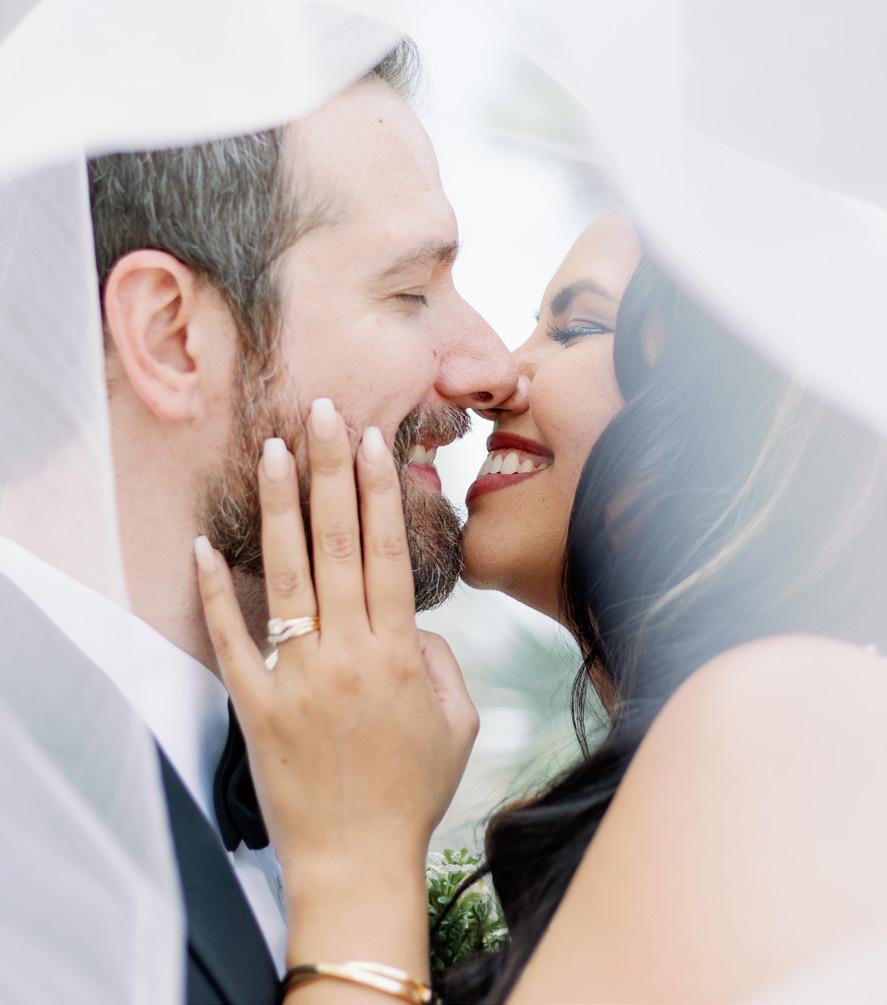
Explore how a happy marriage can lead to better physical and emotional well-being.
Despite comforts and devices, kids need their parents.


Ihad no idea how di cult parenting would be, while at the same time, how rewarding it would be. Elizabeth Stone said, "Making the decision to have a child – it is momentous. It is to decide forever to have your heart go walking around outside your body."
In short, it is an important, terrifying, wonderful, tiring, and humbling job. And now we have a modern age that has handed us enough technology to make the journey even more treacherous. How do we navigate this so we don’t raise a generation of humans who can’t cope with what is coming, let alone what is already
LIFE IS HARD FOR THIS NEW GENERATION AND THEY NEED THEIR PARENTS TO TEACH THEM AND GUIDE THEM FROM OUR EXPERIENCES–SUCCESSES AND FAILURES! DON’T LET YOUTUBE, GOOGLE AND ALL THE OTHER APPS AND CHANNELS OUT THERE EDUCATE YOUR CHILDREN! IT’S YOUR JOB TO DO THAT!
here? They know far more about this technology than we do! How do we stay ahead of them when we barely understand it?
First, the good news. Some things never change. Some principles are eternal. Love your children unconditionally; expect them to obey respectfully; model the faith, character, and lifestyle you want them to adopt. As James Baldwin said, “Children have never been very good at listening to their elders, but they have never failed to imitate them.”
That truth is eternal, no matter what the modern age gives us to make life more comfortable while negatively


Children have never been very good at listening to their elders, but they have never failed to imitate them.
—JAMES BALDWIN
e ecting character. The di culties facing children and parents alike are the same for all of us.
What I mean is that you and I are facing challenges because of the modern world. We have to seal with dangers to our character, and so we are always working to overcome them. In some ways, the issue is the opposite of the adage: “Tough times make tough people.” Why was the Greatest Generation so great? Because they survived the Great Depression and the Second world war. What do we have? Comfort. Comfort is a blessing. I don’t want my kids or me to su er another Great Depression or World War. But comfort also brings challenges, and the modern world has given us great, great comfort.
One of my sons fell into this comfort trap recently. I try to raise my kids through the lens that every day isn’t necessarily fun. You don't get to do whatever you want, not every day.
You put in the work and earn the reward. I teach them self respect and how to be proud of their accomplishments and truly feel proud of themselves when they work hard and see the results pay o .
My 6th grade son made the ‘B’ honor roll. I had been pushing him to study during the week because this is the kid who never
1.
Be PRESENT and aware of what they are doing on their devices.
2. Know that you don’t have to give them all the latest tech and it can be limited exposure.
3.
Never give up! They need their parent(s)! They only have two of them to count on and sometimes just one. They DON’T NEED ANOTHER FRIEND! Make them respect you as their parent, and in turn, they will develop respect for themselves.
SABRINA CICERI EDITORIAL@AKERSMEDIAGROUP.COM
has homework. He says he knows everything and he never has to study so I let him go week after week without pushing him. But I said, “We’ll see when the report card comes home.”
I don't care if the kids make all C’s if I see them work hard and try their best, but I expect all A's if I never see them open a book. He brought his certificate home (they give certificates for B’s now!) and I said, “Oh, ‘B’ honor roll… what that means to me is ‘BE BETTER!’” I actually laughed and caught him o guard. I said, “If you ever tried and opened a book, you would easily make straight A’s. Now I’m going to require you to do 30 minutes each day of something–reading history, science–something.”
He fussed and groaned through the next nine weeks, but something happened to change his attitude.
He finished the year with straight A’s! I was super proud, but seeing his look and how astonished and proud he was of himself was priceless. He said he never thought he could make A’s and that he will always work hard to do his best. I loved it!
All the comfort of today and the technology of entertainment is engineered to lead us and our kids into complacent consuming. God help us, but we have to stay on top of it and control what wants to control us.
Sabrina is a self-confessed go-getter, and owner/ founder of ‘Immunity Health,’ an evolutionary wellness center in The Villages. As published author of “If It’s Not One Thing It’s a Mother”, and having lovingly fostered and adopted many children over the years, it’s no surprise Sabrina and husband Joe were named the 2014 Foster Parents of the Year by Kids Central, Inc.


Ahappy, healthy marriage is more than just a joyful relationship—matrimony can also be a significant contributor to physical health.
While marriage itself doesn't magically produce health benefits, the quality of the relationship plays a crucial role.

Licensed Mental Health Counselor at Ocala’s Silver River Counseling Alan Hickey says numerous studies and research show that a happy marriage can positively a ect one’s health. On the flip side, he notes that people in an unhappy marriage, especially one full of conflict and toxicity, are much more prone to health risks in general.
"It's not like you sign a marriage certificate or say, 'I do' in front of God, your friends and family, and then automatically, you’re bestowed these health benefits,” explains Alan, who has a master’s degree in marriage, couple and family therapy. "The idea is that being in a genuinely happy and supportive marriage can bring a lot of these benefits.”
Research indicates that people in happy marriages experience lower rates of heart disease, fewer

strokes and heart attacks and shorter hospital stays. Plus, they are more likely to survive major surgeries, even cancer. Additionally, they are less likely to develop anxiety disorders or su er from depression. Alan notes that one leading researcher in the field, Dr. John Gottman, with his wife Julie, has linked happy marriages to lower levels of cortisol, the stress hormone.
"When cortisol levels are lower, people experience less stress, which positively a ects the immune system and overall health," Alan says.
Furthermore, a healthy marriage often involves proactive health behaviors.
"Couples in happy marriages are more likely to talk openly about their health concerns and upcoming doctor's appointments," Alan explains. "So, say the wife is concerned about chest pain. The caring husband might urge her to seek some medical attention where she otherwise might not (and vice versa)... When people are happily married, they generally want to live a long life with each other, so they're more likely to accept the influence of their partner.”
Additionally, Alan says not having to deal with a medical situation alone, especially when it might be a serious or scary one, is a major plus.
“Knowing they have a partner who’s willing to show up with them; that they’re not dealing with it on their own, will absolutely ward o some of that depression, some of the pressure,” he adds.
Alan emphasizes that maintaining a happy marriage requires ongoing e ort and mutual
respect. Two of the essential components are continuous curiosity about one's partner and, you guessed it... communication.
"It's not just about knowing their daily routine; it's about truly understanding their psyche and heart ," he explains.
This level of curiosity fosters deep connection and compassion, which are crucial during disagreements.
Disagreements are inevitable in any relationship, but Alan points out that the mark of a healthy marriage is not the absence of conflict but rather how couples navigate it.
Alan also discusses the concept of "enduring vulnerabilities"— issues that may recur throughout a relationship.
"Just because a problem keeps coming up doesn't mean the relationship is doomed," he says. "Some issues are solvable, while others are not. The important thing is how couples approach these recurring problems. Communication strategies, gentle conversation and repair techniques are essential for navigating these challenges.
“Communication is key, but it requires one person to be vulnerable, and it requires the
other person to be receptive. If that doesn’t happen, then communication just sort of breaks down,” Alan explains.
“Communication requires both components to be present for it to be e ective.”
Alan also highlights the importance of mutual goals in a relationship.
.
Alan says he often shares with his clients a powerful metaphor that Silver River Counseling’s Founder Dr. Brent Mruz shared with him.
“A lot of couples feel like they're playing musical chairs, and in that game, there's a distinct winner and a distinct loser, where the winner gets everything that they want and the loser gets nothing that they want,” Alan says. “And rather than finding just a simple compromise, it's about trying to find a way for each party to get all of the things that they both want.
“When they get into that mindset, it’s no longer a game of musical chairs, but it's a three-legged race where they're tied by the leg and they're either going to cross that finish line together or they're going to stumble together. If they stumble, then they’d have to work alongside one another to pick themselves up.”
Alan says that metaphor clearly illustrates the saying, “We’re in this together.”
“Part of crossing that finish line together means that both parties, in the end, are going to have fondness and admiration for each other either way,” he says. “And that alone is going to make it a lot easier to communicate and be receptive to communication.”
ROXANNE BROWN ROXANNE@AKERSMEDIAGROUP.COM
Roxanne Brown is an award-winning journalist with 20 years of experience in the industry. She joined Akers Media as a Sta Writer and Copy Editor in July 2020 after 16 years as a local newspaper reporter. Roxanne lives in Clermont with her family, and outside of work, enjoys reading, sunsets, music, history, and Zumba.



“Senior Moments” can be just that — A Senior Moment!
But Alzheimer's disease also begins as "senior moments"


Dr. Craig Curtis, National Alzheimer's Expert and Navy Veteran, is on a mission to help everyone Be Alzheimer’s Aware. As part of that mission, he provides FREE services to the residents of The Villages and surrounding areas.
Memory Screenings
· Get evaluated by a professional
· Non-invasive
· Recommended yearly
Weekly Seminars on Healthy Brain Aging
· Causes of memory loss and proper diagnosis
· Memory and forgetfulness — what is normal?
· Alzheimer's disease versus dementia
· Proper brain nutrition
· Recent discoveries in Alzheimer's disease, treatment and prevention
Clinical Trials for Memory Loss and Memory Loss Prevention
· No insurance involved
· You may be compensated for your time and travel
· Contribute to finding a cure for Alzheimer’s disease
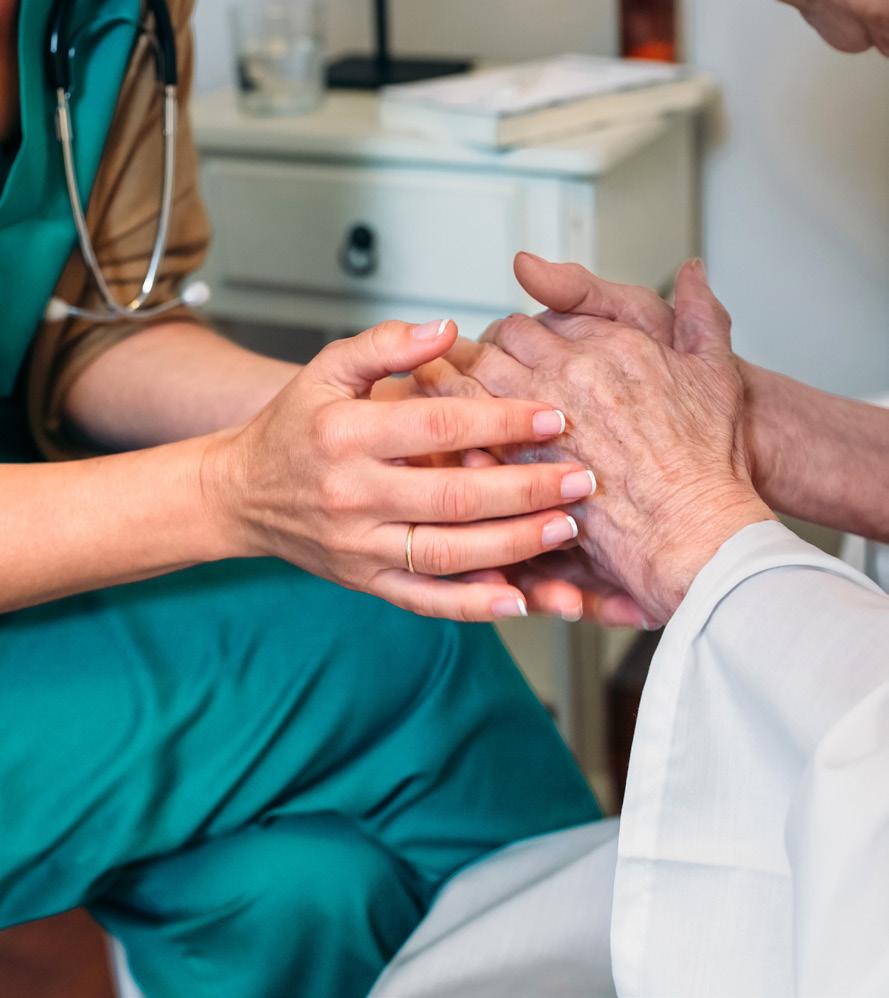
A Health Savings Account can help you save more than your life.
STORY: GINA HORAN
Most of us have heard of a 401(k), the pretax retirement savings plan that allows employees to contribute a portion of their wages to an investment account.
A Health Savings Account (HSA) works in much the same way by allowing you to save tax-free money you can put towards medical costs.
“The HSA is a type of personal savings account that can be set up to pay for certain health care costs and allows individuals to put money away and withdraw it tax free, as long as it is used for qualified medical expenses, like deductibles, co-payments, coinsurance and more,” says Stephanie Massey, a spokesperson for the Centers for Medicare & Medicaid Services (CMS).
According to Massey, an HSA can be beneficial for those who need supplemental insurance to lower out-of-pocket health care costs.
What's considered an HSA-eligible plan?
Under tax law, HSA-eligible plans must set a minimum deductible and a limit (or maximum) on out-of-pocket costs for individuals and families. The minimum deductible is the amount you pay for health care items and services per year before your plan starts to pay.
The maximum out-of-pocket costs are the most you’ll have to pay per year if you need additional health care items and services.
HSA-eligible plan deductibles are often significantly higher than the minimums and can be as high as the maximum out-of-pocket costs.
One advantage is a tax advantage. You can put pretax money in an HSA and you aren't taxed on the withdrawal as long
as you spend it on medical eligible items, copays etc.
Some people treat an HSAeligible plan like a retirement account. They fully fund it every year and never spend it until they retire or become eligible for Medicare (it can be used to pay Medicare part B premiums). That allows the account to grow tax free and funds can be
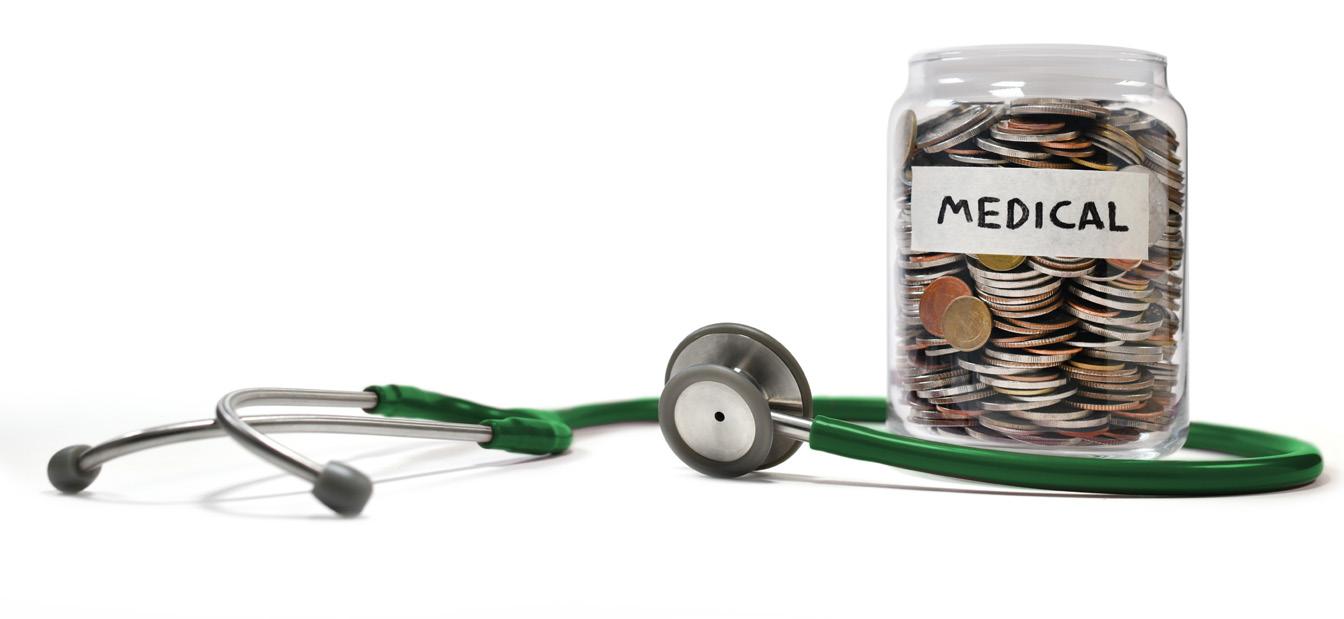

withdrawn tax-free for medical expenses, which tend to get higher as you age. It also lowers people's taxable income. For example, in 2024, $8,300 can be contributed pretax if you are a family of two or more. Plus, if you are over 55 you can contribute another $1,000 for $9,300 total.
Those of us who don’t have a bachelor’s degree in health insurance and a master’s degree in tax law can consult local specialists like Robert Buckmann, a Eustis-based insurance guru at Mid-Florida Agencies.
“There are three types of people who can benefit from an HSA,” Robert says. “The very sick, the extremely healthy, and someone to wants to use this as a ‘retirement’ account.”
Upfront costs can be shocking for a person who is extremely ill, but according to Robert it pays o in the end. That’s because it tends to be the cheapest option when you take the monthly premiums and add the out-of-pocket
maximum. Someone who needs multiple surgeries or hospital stays benefi t from that type of plan.
“About four years ago, I had a client who needed a double lung transplant and he unsurprisingly had some reservations about paying so much out of pocket,” he says. “I had to remind him that yes, he was going to be paying for everything, but once he hit the out-of-pocket amount and stayed in-network, there was no limit or maximum that he had to contribute.”

“I wish I started doing this much earlier,” he says. “Now I contribute the max each year and because it’s growing I can use it for my Medicare plan.”
According to Robert, the second typical beneficiary of the HSA plan is the very healthy person. That’s because the plan acts as catastrophic coverage — money in case you get into an accident or have some other unforeseen situation. And it tends to have a lower premium than most plans and an out-of-pocket max limiting the clients’ exposure. Someone who only needs wellness and possibly generic meds benefits from the lower premium.
The third type of person can benefit just from the savings, like Robert, who at 57 isn’t just an agent but a client who takes advantage of the opportunity.
He wants to make it clear that to spend the money, you don’t have to be on the plan but in order to contribute, you must be on a plan.
“I have a lot of current clients on certain plans, depending on their monetary and health situation,” Robert says. “Most are 64 and under because by that time they are on Medicare.”
Robert, who has been operating on a referral-based, word-of mouth basis since 2017, says he recognizes that the whole process can be confusing and frustrating, which is why he loves helping people.
“I can’t tell you how many times people have broken down crying because they appreciate the help,” he says. “It’s not a hard sell because I genuinely care.”
To find out which states have HSA-eligible plans through the Health Insurance Marketplace®, you can preview plans with price estimates at HealthCare.gov/see-plans
For more information on HSAs visit healthcare.gov/glossary/health-savings-account-hsa/ or consult individual insurers if you have questions about their benefits (including HSAs), coverage, etc.
GINA HORAN GINA@AKERSMEDIAGROUP.COM
Gina moved to Central Florida in August of 2021 and has a background as a features writer, morning radio show cohost and producer. She covered travel, events and the restaurant scene for television and her passions include road trips, history books, baseball and landing in a new city with no map or guidebook. She lives in Oxford with her cat.

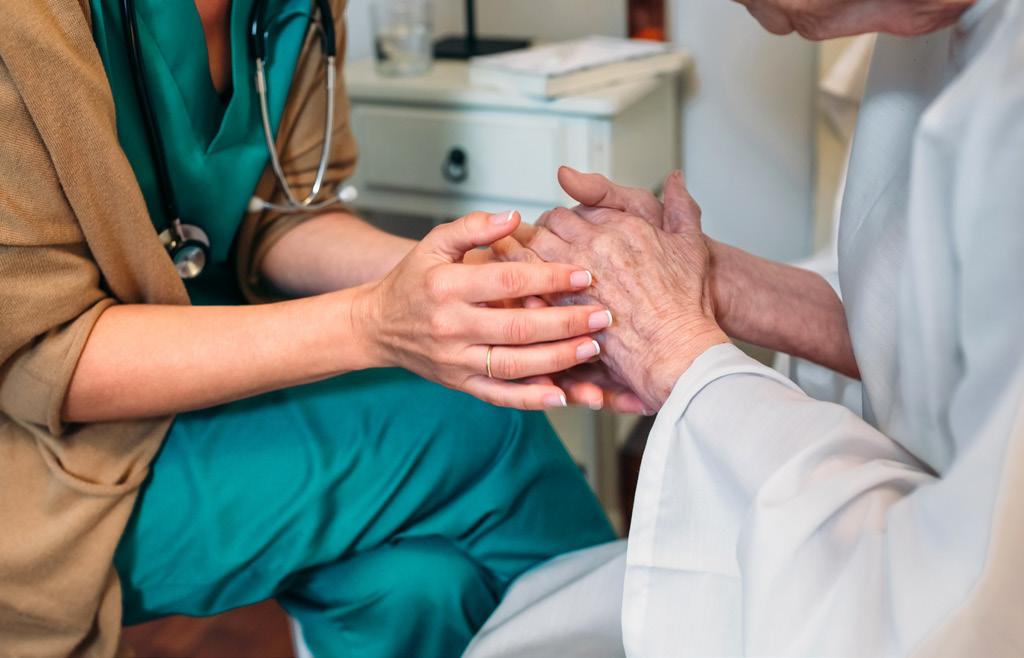
Direct Primary Healthcare may be the future of insurance.
STORY: GINA HORAN
Dragging ourselves to the doctor’s o ce is rarely a fun activity, but it’s usually less painful than navigating your insurance company’s rigmarole and endless paperwork that comes with medical care.
Combine the two and it’s a wonder people seek medical treatment at all.
Direct Primary Healthcare (DPC) may o er a solution to this necessary nuisance, or at least present an alternative.
DPC, which covers the cost of basic, routine exams or minor emergencies, is a relatively new option in which you make payments directly to a healthcare professional, usually practitioners in internal medicine, family medicine or pediatrics. Services may also be provided by nurse practitioners and physician assistants.
Using DPC is essentially like having a retainer with your
primary care physician in case you need them through a type of “membership.”
“As a provider, the most frustrating thing is dealing with insurance,” says nurse practitioner Amy Ester, who opened Anchored in Health in Oxford in 2021 because she didn’t want to be restricted by the established health care model.
“I worked in the traditional health care space for years and just wanted to care for my patients without making quotas and dealing with mountains of paperwork.”
Amy says that personalized care is critical as it is practically impossible to establish a good, quality relationship by only
spending 10 minutes with a patient.
“I saw so many people when I was working within those parameters and I couldn’t tell you about one single person or how I treated them even if I tried because in 20 minutes, you can only cover so much,” she says.
Now, Amy knows every one of her patients personally. Many of them even have access to her cell phone number in case they need her.
“My patients deserve value and respect and that’s what they get,” she says. “I spend at least an hour with each one because to me, they aren’t just another number.”
Amy o ers di erent plans at her practice and she can help with everything from preventative health maintenance and family planning to other types of issues. A single person of a certain age will start at a $59 monthly membership and the plans go up to a $250 monthly membership for a nuclear

family. Patients just leave a credit card on file.
“I did my research and have set my prices so there is really something to help everyone with access and a ordability,” Amy says.
She also contracts with a local lab and gives patients access through a portal.
Leesburg nurse practitioner
Amanda Gaskin has also adopted the DPC way of care and is a true believer.
“This has been my model of payment since day one,” says Amanda. “It’s right there in our name, Ultimate Health Direct Primary Care.”
Amanda previously worked elsewhere as a provider beholden to insurance companies that dictated what she could and could not do for her patients.
“I wanted my patients to be at the center of the care,” Amanda says. “This model benefits anyone needing health care services and increases the patient’s ability to determine what is best for them as it relates to their health. With or without insurance, this model works for me and my patients.”
She charges $99 per month with no contract, but the agreement can be modified based on needs. For example, she adjusts the rate for some of her patients who are seniors living on a fixed income. They pay $50 per month to have 24/7 urgent care access while keeping their DPC through their insurance.
To supplement DPC in the event of a major emergency requiring hospitalization, Amanda recommends either a health share program like Zion Health or a high deductible plan.
More time with your primary healthcare professional
Upfront pricing
Accessibility and convenience
You may need supplemental insurance for lab work or specialists
Membership does not count towards a deductible
Amanda and the order was sent over to the imaging center from Amanda’s cell phone. There was a minimal delay in getting treatment because of the direct care model.
“She was referred to Mo tt Cancer Center quickly because DPC helps facilitate care coordination much faster than with traditional medicine,” Amanda says.
Another local patient, Heather Figel, says she was looking for a new doctor and found Ultimate Health Direct as a recommendation through her friend Sarah. Heather says the compassion, understanding and availability of the entire team there made her a patient for life.
OF DPC TO FIND A DPC NEAR YOU:
“Amanda is the only health provider I trust or see now,” Heather says. “After being sick, I went to see her, she got me in immediately and I knew I found my home.”
Anchored in Health
4060 Thomas St., Oxford
May not work with Medicare or Medicaid
Amanda says there are so many ways this access can help people and cites one example of a situation that occurred this past year.
“A young lady was in an accident and came to me because her abdomen was hurting,” she says. “It turned out to be cancer which required her to see me weekly for imaging reviews.”
For those reviews, the patient simply sent a text message to
GINA HORAN GINA@AKERSMEDIAGROUP.COM
352.203.3074
Ultimate Health Care
733 N. 3rd St., Leesburg
352.901.6582
Walden Direct Primary Care
111 SW 8th St., Ocala
352.619.0029 -or-
516 E. Main St., Leesburg
352.306.2167
Ellis Integrative Family Practice
1865 Nightingale Ln. Ste. #B, Tavares
352.508.5418
Gina moved to Central Florida in August of 2021 and has a background as a features writer, morning radio show cohost and producer. She covered travel, events and the restaurant scene for television and her passions include road trips, history books, baseball and landing in a new city with no map or guidebook. She lives in Oxford with her cat.





ENERGY EFFICIENT HOME FOR SALE NEAR THE VILLAGES
Upon entering the community you will appreciate the well-kept landscaping, pool, tennis/pickleball courts and more. This 1,911 sq.ft., three-bedroom plus a den has two bathrooms and an open floorplan great for visiting with family and friends. The kitchen has solid wood cabinets, granite counter tops and easy access to the laundry closet, den and garage. Directly off the kitchen is a bonus room that leads to a tropical backyard patio and a firepit. The spacious primary suite has a private bathroom, two walk-in closets, dual granite sinks, walk in shower with seamless glass doors and a private water closet. Luxury finishes throughout with crown molding, ten-foot ceilings, Bahama shutters on the expansive front porch, bamboo and tile flooring throughout, solar panels, additional insulation in the attic area and a long driveway leading to the side entry garage. This community has a low HOA and electric bills.

$449,900




A joyful heart is the health of the body, but a depressed spirit dries up the bones.

PROVERBS 17:22
